Wakami River
Ontario, Canada
June 1 - 10, 1990
The Wakami was our first trip with a crew of five in two canoes. The trip was so rough, we needed a spare paddler; by the end of the trip we nearly needed a spare canoe. It began with a flat tire, threatening winds, and a thunderstorm. We experienced both snowfall and warm sunny days as we traversed beautiful lakes and rivers with numerous rapids and waterfalls and rugged portage trails. Moose encounters were frequent, human encounters rare, and the black flies and mosquitoes were relentless. Everyone endured some pain and discomfort, but no one would have wanted to miss this trip. This was Jim Brown's first journal. - L. Walter
Friday, June 1
Last-minute pandemonium; canoe rental hassles and final preparations.
With the trip only hours away, my day at work seemed like a desperate struggle to tie up an ever growing number of loose ends. In our phone conversation the night before, Walter had noted the same phenomenon: his workload had turned into an avalanche during the last few days before the trip. Apparently Rob was also going to be delayed by work, so that the Ohio contingent might not reach Ypsilanti until midnight. It was as if some malicious force were conspiring to undermine what we had planned for many months.
This almost paranoiac feeling was reinforced when I called Canoe Sport around noon to confirm the rental arrangements for the canoe. The person with whom I spoke seemed confused about the whole affair and could only tell me he'd call back within an hour. Doug called twice to find out what was going on, but I could only tell him I was waiting to hear from Canoe Sport.
Finally I received the critical phone call: Everything was ready for us to pick up the canoe at 4:30 that afternoon! Utter relief!! After that, I was almost oblivious to the pandemonium at work.
Even so, just after 3:30 I shifted into hyperdrive to escape last minute petitions, requests, and work assignments, so that I could be sure to reach Canoe Sport by the appointed time. Doug and I left Dearborn independently at about the same time, struggled through the some frustrating traffic jam on 1 94 near Detroit Metro Airport, and managed to arrive at Canoe Sport within a few minutes of each other and only a few minutes late.
When Doug arrived, I was at last able to see the extension he had designed so that the rack on his Aerostar would support two canoes. Pretty impressive! It looked neat and sturdy: more than adequate to do the job. After briefly conversing with the Canoe Sport manager, we brought the canoe out and set it beside the Aerostar. It was a Mad River Explorer, a beautiful scarlet kevlar canoe with yellow flotation begs in bow and stern and a yellow skirt for white water canoeing. It sort of brought to mind my boyhood comic book hero, the Flash.
As we hoisted the Explorer onto the Aerostar rack, we were pleased at how light it felt, but also somewhat disturbed that it felt so much more fragile than Walter's Old Town Tripper. We started to use Doug's parachute cord to tie down the canoe, but a woman employee of Canoe Sport insisted that we use their rope (which appeared to be about the same) and generally fussed over the tie down until she was satisfied that the canoe wouldn't blow off the rack on the freeway. 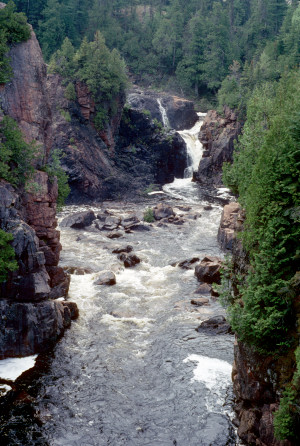 With our attention focused on the tie down operation, we forgot about the PFDs that were supposed to come with the canoe rental package. Fortunately, Doug had his own personal PFD, and Taylor and I were later able to use extra PFDs that Walter brought with him.
With our attention focused on the tie down operation, we forgot about the PFDs that were supposed to come with the canoe rental package. Fortunately, Doug had his own personal PFD, and Taylor and I were later able to use extra PFDs that Walter brought with him.
Finally, we completed the paperwork for the rental, wandered around the store briefly to pick up some last minute supplies, then departed for our separate homes. Doug wanted to do some errands around his house in Southfield before joining us at the rendezvous point.
The plan was for all the voyageurs to rendezvous at 11:30 that night at my house in Ypsilanti. We would then leave for Canada as soon as we had transferred the Tripper to the Aerostar and consolidated all the bags and supplies in the Aerostar and my Lincoln Continental. The idea of using a luxury car like the Continental in the wilds of Canada might seem rather peculiar, but we wanted to take advantage of the fact that the Continental, like the Aerostar, was a lease vehicle.
When I reached home, I found as much pandemonium there as at work. The boys had their friends over and were playing video games and watching Pistons vs. Bulls on TV. Emily was preparing to chaperone an all night senior party at Ypsilanti High. She stuck around long enough to sew a rip in my gortex pants, to pick up some blueberry muffins and oatmeal cookies from a local bakery, and to brew coffee for the voyageurs.
At around 10:00 I called Taylor to let him know that Rob and Walter would probably not arrive until after 11:30. Pandemonium in the Taylor household, too: they were having a sleepover for the girls. Even so, Taylor was the first to arrive at the rendezvous point. He showed up at about 11:30, despite getting slightly lost and having trouble identifying the address numbers on our house. We put his gear in the trunk of the Lincoln, then talked about the impending trip for awhile. But by midnight we were growing concerned that there was no sign of our fellow voyageurs.
Saturday, June 2
The "Ypsi Why? Angle"; loading the vehicles; the trip north; breakfast at Smiley's; obtaining permits and licenses; rough shortcut on Route 556; excursion to Aubrey Falls; arrival at Wakami Provincial Park and a flat tire; Jim and Doug travel to Chapleau for tire repair and food and to leave the Aerostar at Horwood Lake; Walter, Taylor and Rob take a perilous trip across windy Wakami Lake to find a campsite; the difficult return to park headquarters paddling into the wind; separated by darkness and a fierce storm; windy nighttime paddle to the camp on Wakami Lake.
Walter and Rob showed up around 12:15, after getting lost only a block away. Ypsilanti was beginning to take on the aura of the Bermuda Triangle. "The Ypsi Why? Angle" seemed an appropriate name for this phenomenon. Apparently the "Ypsi Why? Angle" had swallowed up Doug.
While Emily was serving coffee and cookies to the assembled voyageurs, Walter suddenly disappeared. We began to wonder if the "Why? Angle" had claimed another victim. But it turned out that he was outside greeting Doug, who had at last turned up after, of course, getting lost in Ypsilanti.
General confusion ensued as we struggled to come to grips with such vexing questions as who, and what gear, would go in which vehicle. Walter and Doug removed the Tripper from Walter's Toyota van and set about securing it to the homemade rack on the Aerostar, Little progress was made in the darkness, and it quickly became apparent that we needed a flashlight. I ran into the house to fetch my rechargeable Coleman spotlight. It helped so much that I decided to take it along on the trip.
In the spotlight, everyone marveled at Doug's engineering feat. There had been some question whether the Aerostar would be able to transport two canoes without a roof gutter to anchor a standard canoe rack. Walter had even developed an extension of the rack on his Toyota in case the Aerostar rack failed to work out. But Doug's rack was solid and well built, and once the Tripper was secured to it, all doubts were removed as to whether it would hold up under freeway conditions.
Most of the gear went into the back of the Aerostar. Taylor decided to ride in the Lincoln because his gear was already there, and Walter opted for the Lincoln so that he could sleep in the back seat. Rob ended up at shotgun in the Aerostar. Walter and I wondered how long it would take for Rob to drive Doug crazy. We figured that unmitigated exposure to Rob would provide a real initiation for Doug into the group and would also measure his ability to withstand the rigors of the impending expedition. We thought that if he could survive Rob, he could survive anything.
Finally, at 1:30 AM, I piloted the Lincoln to US 23, and our mini caravan set off for the Great White North. Once on the freeway, we decided to follow behind the Aerostar to spot any problems that might arise with the canoes. Walter slept fitfully in the back seat of the Lincoln. Besides sheer fatigue, he was battling a cold that had struck only a couple days before the trip. Taylor alternated between conversation and light naps.
The trip up US 23 and 1 75 was relatively uneventful until we reached Grayling, where we stopped for gas and snacks at an all night convenience store. Taylor took over driving the Lincoln. Doug decided to remain at the wheel of the Aerostar, but had some trouble finding the way back to 1 75 north in the darkness. Later, as we approached Mackinaw City at dawn, he decided to pull into a free rest area and turn the wheel over to Rob. Crossing the Macinac Bridge, we noted how calm the waters looked a remarkable contrast from the White River trip two years earlier, when strong winds had whipped up alarming white caps in the straits.
At about 7:00 AM, Rob suddenly pulled off the freeway in the Upper Peninsula and headed for a package liquor store called the B&D Market. Walter moaned that Rob was out of control. But as it turned out, Rob and Doug merely needed to relieve themselves of a thermos worth of coffee. Since the johns were closed at that hour, they had to use the woods behind. There they noticed an abundance of fat, hungry mosquitoes a sobering portent of things to come.
We had originally planned to stop for breakfast in Sault Ste. Marie, Michigan. But when we reached the Sault, Rob drove on across the bridge and through the Canadian custom booths. "Out of control," Walter muttered again. As we pondered our breakfast predicament while waiting in line at the booths, we noticed just off the road a large trailer advertising Jane's Exotic Circus. The ad featured a vivid and somewhat garish picture of a nude woman and a dog cavorting in a cow pasture. We were amazed to learn later that Rob had completely missed this spectacle.
After cruising around Sault Ste. Marie, Ontario, for some time, we came upon a lively spot for breakfast: Smiley's Pancake House. When we saw the tour buses in the front, we took an instant liking to the place. Moments later we were seated and ready to order. Walter and I opted for the buckwheat pancakes. Doug eyed the "Kitchen Sink", a meal designed for Rocky Balboa in training, but passed on it when no one else was willing to split it with him. He finally settled on Smiley's #2, as did Rob. Taylor went for Smiley's #1.
While we eagerly scarfed down the goodies, we discussed a shortcut Walter proposed: taking Route 556 instead of Route 17 to get to Route 129. Rob provided the only opposition to this proposal, more out of protest against Walter's taskmaster approach to the question then out of any particular concern about the route. This waggish disputation between Walter and Rob would provide us with much entertainment for the rest of the trip. During our breakfast, we also asked the restaurant manager where we could get camping and fishing licenses. He recommended the Trading Post a few miles down the road.
We departed Smiley's at 8:30 AM, with Walter at the reins of the Lincoln and Taylor riding shotgun. I joined Doug and Rob in the Aerostar. Rob was still pretending to fume about the Route 556 decision. When Walter pulled over at what he thought was the Trading Post, Rob pressed on in the Aerostar, determined to emphasize the soundness of his own driving judgment. In this particular case, he succeeded. The Trading Post turned out to be another mile down the road.
As with many places, Ontario requires hunters and fishermen to purchase licenses to pursue their sport. But Ontario also requires that "foreigners" purchase licenses if they intend to camp anywhere in the province. Where we were going, it was unlikely that anyone would be in a position to check for our camping licenses. But we felt obligated to pay the $3 per day per person, if only to show our support for Ontario's commitment to maintain the wilderness for the enjoyment of people like ourselves. After standing in line for some time listening to the locals talk about bear hunting, we obtained all the necessary licenses and departed the Trading Post.
At the start of Route 556, we noted a rather ominous sign: "No fuel for 82 KM." The Aerostar was, of course, low on fuel at this point. The road itself turned out to be even worse than Rob could have I imagined: a horrible, winding, hilly, dirt and-gravel washboard of a road that seemed to go on forever. As Walter set out at breakneck pace in the Lincoln, Rob followed in the Aerostar, weaving through clouds of dust as we sang the theme song from "Dukes of Hazard." Along the way we crossed the Mississagi and Abinadong rivers, both of which we had considered as alternatives to the Wakami trip. We also came upon a large porcupine ambling across the road. Eventually the buckwheat pancakes began to weigh heavy in my stomach, and my attempts to make notes in the log only contributed to the malaise. It was like trying to write during a roller coaster ride.
Finally, at about 10:00 AM, we reached Route 129. Soon afterwards we came upon a service station near another sign that read, "No fuel for 63 KM." Stopping here for gas, we encountered our first noticeable black fly population.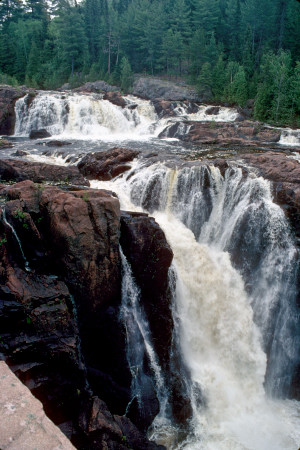 The little buggers were annoying and persistent, but they didn't seem a menacing as I expected. Walter, however, found them menacing enough to warrant the label "kamikaze gnats". We felt somewhat vindicated when the female attendant recommended Avon Skin So Soft as a repellent. Christy Walter had obtained 4 bottles of the stuff for us. On the other hand, we were shocked at the bill for the gasoline: $58 for about 25 gallons! As it turned out, this was the least expensive gasoline price we encountered in Ontario.
The little buggers were annoying and persistent, but they didn't seem a menacing as I expected. Walter, however, found them menacing enough to warrant the label "kamikaze gnats". We felt somewhat vindicated when the female attendant recommended Avon Skin So Soft as a repellent. Christy Walter had obtained 4 bottles of the stuff for us. On the other hand, we were shocked at the bill for the gasoline: $58 for about 25 gallons! As it turned out, this was the least expensive gasoline price we encountered in Ontario.
A short time later we visited Aubrey Falls, which is at the approximate terminus of the upper Mississagi River route. Here we put Skin So Soft to its first real test. Walter didn't trust it yet, so he decided to put it on one arm and Muskol on the other as a control. Skin So Soft seemed to work veil enough, but at Aubrey Falls we didn't really encounter the swarms of black flies we were later to encounter on the portage trails. I also tried my electronic bug repeller, but it had scarcely any effect at all.
After spending a while clambering around the rocks near the falls and taking photographs, we returned to the vehicles and headed north toward Wakami. We had anticipated a relatively smooth ride up Route 129, but were disappointed to find that most of the paved highway had been demolished and replaced with gravel. We arrived in Wakami Provincial Park at around 1:00 PM. We were directed to the staff parking area adjacent to a motley assemblage of crude buildings along the shore of Wakami Lake. There we would be able to launch the canoes and also park the Lincoln for 7 days.
Shortly after we pulled into the parking area, Walter noticed that the right rear tire of the Aerostar was flat. Since no one could remember any obvious blow that might have caused the flat, we assumed, with a rather sinking feeling, that we must have been riding on the flat tire for some time and that it must therefore be damaged beyond repair. There was a spare, of course, but it was one of those undersized temporary tires that come with a warning, "Do not exceed 50 mph." This constraint would delay our moving the Aerostar to the takeout point over 120 miles away by road. In any case, we couldn't afford to drive around these gravel roads without a spare. We'd have to repair or replace the flat tire.
While Doug was changing the tire (with the fortuitous assistance of the park staff), the rest of us unloaded the canoes and the gear and carried everything over to the boat launch. After some discussion, we decided that Doug and I would get the tire repaired/replaced at a service station in Chapleau enroute to the takeout point. We could also pick up dinner for the whole crew at a delicatessen in Chapleau. Meanwhile Rob, Walter, and Taylor would load the Tripper and take it across Wakami Lake in search of a suitable campsite. When Doug and I returned that evening, we would find the rest of the gear loaded into the Explorer and Walter and Taylor waiting to guide us to the campsite. That at least was the plan. No one realized at this point how long Doug and I would be on the road or how much the weather would interfere with the attempt to find a campsite. For the time being, at any rate, it was sunny, warm (about 80°), and a bit humid, with massive cumulus clouds scattered across the sky in patterns the park staff described as "building up to thunderheads".
I took dinner orders all ham and swiss on rye, except Rob, who was very explicit about wanting a bologna and American cheese on white bread with lettuce, mayonnaise, and mustard, plus a sixpack of beer. At Doug's suggestion, we put the damaged tire in the trunk of the Lincoln, and I took off at breakneck speed toward Chapleau, while he followed at a safer pace in the Aerostar. Along Route 667 I nearly did break my neck in the minefield of potholes that dot the highway (the roadbed had deteriorated alarmingly since we first encountered it on our Sakatawi trip 9 years earlier). But on the positive side, I spotted a moose at the edge of the road. It lumbered back into the woods when I slowed down to observe.
By the time Doug arrived in Chapleau, I had already had the tire repaired at a Petrol Canada station. Surprisingly, and much to our relief (given the apoplectic prices), the tire re just needed a plug. While Doug exchanged the repaired red tire for the spare, I proceeded into Chapleau to look for dinner.
Chapleau is a typical Canadian small town, with a curious admixture of structures for homes, businesses, and industry, and an economy largely geared to hunters and fishermen who come to exploit the Chapleau Crown Game Reserve billed as the largest game reserve in the world. To get to the downtown area, I had to drive past it, then cross the railroad tracks on a lofty overpass on the north side of town, then double back into town.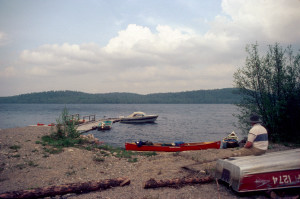 There I found a takeout food place at the back of a small "confectionery" (apparently the Canadian term for a convenience store like 7 Eleven). Unfortunately, the takeout operation specialized in Chinese food, and the ladies at the counter were themselves Chinese who spoke only rudimentary English. After repeating my order several times, I had to settle for "ham and white cheese on white" instead of "ham and swiss on rye". For Rob's order I was in danger of getting "macaroni" instead of "bologna"; so I settled for "ham and yellow cheese on white". To fill Rob's beer order, I had to go to a separate beer specialty store near the Overpass.
There I found a takeout food place at the back of a small "confectionery" (apparently the Canadian term for a convenience store like 7 Eleven). Unfortunately, the takeout operation specialized in Chinese food, and the ladies at the counter were themselves Chinese who spoke only rudimentary English. After repeating my order several times, I had to settle for "ham and white cheese on white" instead of "ham and swiss on rye". For Rob's order I was in danger of getting "macaroni" instead of "bologna"; so I settled for "ham and yellow cheese on white". To fill Rob's beer order, I had to go to a separate beer specialty store near the Overpass.
By the time I returned to the Petrol Canada station, Doug had long since changed the tire and was ready to depart for Horwood Lake. The trip to Horwood took about 80 minutes, mostly on Route 101, the best highway we'd seen since Sault Ste. Marie. Along the way I spotted another moose at the side of the road. We nearly missed the turn off to Route 616 because it was not well marked. This road turned out to be the worst yet: 8 miles of washboard with gaping potholes that threatened to pop the plug out of the repaired tire. Along the way we passed the driveway to the Woodhouse Camp, our takeout point 9 years ago. Finally we come to the public launch we sought. There we parked the Aerostar, looked around for landmarks we might be able to spot from the came out on the lake (we didn't see any), then departed in the Lincoln. The time was about 6:15 PM.
The return trip was delayed somewhat by a Canadian National freight train crossing the highway just west of Foleyet. We reached the outskirts of Chapleau at about 7:30, refueled the Lincoln, then headed for Wakami. On Route 667 we ran into a terrific thunderstorm that made the minefield even harder to negotiate. We began to wonder if we would be able to canoe across Wakami Lake to the campsite the others had picked out. Eventually we outran the storm.
When Doug and I reached Wakami at around 8:30 PM, the road was still dry, but the storm was right behind us. Walter and Taylor were waiting for us in one of the park staff cabins, where they had taken refuge from the lightening. They explained that the campsite was about 45 minutes away across the lake and that they had left Rob there to set up camp. They also filled us in on their harrowing experiences.
Shortly after Doug and I had left in the vehicles, Walter, Taylor and Rob loaded the Tripper and embarked on Wakami Lake. By this time the wind and waves had become menacing. Finding it impossible to cross the lake directly or to make it around the northern headland, they were driven ashore on the northwestern bank with waves crashing over the stem and gunwales. After regrouping and bailing (and a brief discussion with the park staff, who had observed the epic struggle with some interest) they pushed off again directly into the strong headwind and relentless waves. They paddled furiously to get out from shore, then quickly between waves rotated the canoe and angled toward the headland. By a process of tacking and ferrying into the wind and skirting the lee side of islands, they eventually reached the other side of the lake and relative safety. After some exploration, they managed to locate an established campsite, where they put into shore and quickly unloaded the canoe.
When it was time for them to return to the park headquarters, no one wanted to go. It had been dangerous out there, and no one wanted to tempt fate again. Nevertheless, the two Larry's returned to the canoe while Rob stayed in camp, courageously volunteering to protect the tent from blowing away. The return trip across the lake directly into the wind was excruciatingly hard work. Walter was again in the stern prying hard to keep the canoe on course, while Taylor paddled hard and tried to maintain his balance as the canoe slapped down hard over the crest of each wave.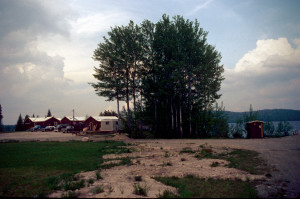 Upon reaching the landing back at park headquarters, Walter and Taylor loaded the other gear in the canoes, fought off the black flies, which seemed undaunted by the stiff wind, and worried about the whereabouts of me and Doug. They also worried about the booming thunderheads and the approaching darkness.
Upon reaching the landing back at park headquarters, Walter and Taylor loaded the other gear in the canoes, fought off the black flies, which seemed undaunted by the stiff wind, and worried about the whereabouts of me and Doug. They also worried about the booming thunderheads and the approaching darkness.
Upon our return, we joined in the worrying. We discussed whether to attempt crossing the lake before the storm broke. Dusk was approaching, and it was risky to delay the attempt into darkness. Nevertheless, we decided to wait a wise decision considering the havoc that ensued only a few minutes later. The storm broke with high winds and ferocious lightning. We retreated again to the park staff cabin and reluctantly began working on a contingency plan to spend the night there. Meanwhile Walter and Taylor munched on their sandwiches and downed some of the beer.
Surprisingly, the storm lasted no more then 20 minutes. When we could no longer hear any thunder, we hopped into the canoes and set off across the lake in the deepening dusk. It was just after 9:00 PM. The winds were still pretty strong, and Doug and I discovered that the Explorer did not behave very well in waves. After nearly capsizing several times, we decided to tack into the wind, heading south at an angle that would ferry us over to the east shore of the lake. By the time we came about to head back north toward the campsite, Walter and Taylor had disappeared, and we could only hope that we'd run into them before it became too dark to see.
We paddled furiously for about 20 minutes until we spotted them waiting for us in the lee of a point of land that jutted out into the lake from its east shore. Soon afterwards, with barely enough light to see, we reached the campsite. Rob was delighted to see us. He had begun to suspect that he might have to spend the night there by himself. He was also glad to get his sandwich and a long awaited can of beer.
The campsite was an attractive, nicely wooded, 3 tiered site. Walter's tent, a Sierra Design's Octadome, had been pitched on the lowest tier near the water.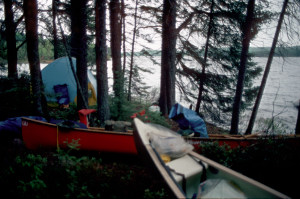 A kitchen area with campfire had been set up on the middle tier about 15 yards away. Doug, Taylor, and I set about erecting my tent in a cleared area on the upper tier about 15 yards above the kitchen area. We were pleased at how quickly and easily my Eureka Overlander tent went up. Darkness had fallen by now, the mosquitoes were out in force, and we were numb with fatigue.
A kitchen area with campfire had been set up on the middle tier about 15 yards away. Doug, Taylor, and I set about erecting my tent in a cleared area on the upper tier about 15 yards above the kitchen area. We were pleased at how quickly and easily my Eureka Overlander tent went up. Darkness had fallen by now, the mosquitoes were out in force, and we were numb with fatigue.
After some brief exchanges about the day's events, everyone turned in at about 10:30 PM. Rob and Walter were in the Octadome. Taylor, Doug, and I were in the Overlander, with Doug in the middle (because his inflatable mattress took up the most room), Taylor on the right, and me on the left. We kept these sleeping arrangements for the rest of the trip. It rained intermittently all night, at times pretty heavily. For the most part, everyone slept pretty well, despite the damp conditions, because none of us had had more than a couple hours sleep in the previous 36 hours (although Rob at least led managed to take a nap while he was waiting for us). Throughout the night we heard the calls of loons intermixed with the more or less continuous hubbub of spring peepers.
Sunday, June 3
Morning lethargy; paddling arrangements; portage around Wakami Dam; wading and paddling the shallow Wakami River; lunch below the railroad tracks; Portage around Sultan Dam; cold weather paddling; lengthy and brushy portages to a makeshift dam/bridge below Sultan; Paddling and wading with Hellpack II; cold soggy camp at the end of the portage; snowfall.
Dawn came soggy and overcast, with temperatures in the mid 50's. Taylor woke up shortly after 6:00 AM and couldn't get back to sleep. He decided to brush his teeth and survey the camp in the meager morning light. He considered trying to start afire, but couldn't find any dry wood. He also considered coming back into the tent, but decided against it for fear he'd bring with him the swarms of hungry mosquitoes. Finally, in rain gear and headnet, he fell back asleep in Rob's canoe chair near the fire ring.
The rest of us roused ourselves at around 7:30. We lethargically set about getting our things organized, taking a few photographs, eating breakfast, and preparing to break camp. Breakfast consisted of bagels with apple butter, blueberry granola, and hot coffee made from Taster's Choice instant. 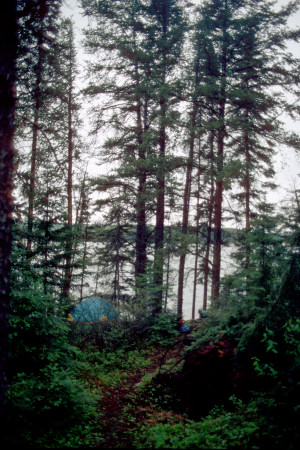 At this point we had not yet established any kind of camp routine; so it took us quite a while to break camp.
At this point we had not yet established any kind of camp routine; so it took us quite a while to break camp.
We finally broke camp at about 10:45 AM. Walter and Rob set off in the Tripper, with Walter at stern. Doug, Taylor, and I started in the Explorer, with Doug in the bow and Taylor in the middle. We had decided to put most of our weight in the Explorer because it supposedly had a greater carrying capacity then the Tripper (1200 pounds vs. 1000). We also thought the extra weight might make it more stable on the lake. This decision to load up the Explorer would prove to be our biggest mistake of the trip. For the time being, anyway, the extra weight didn't seem to help. The canoe still seemed tippy, and it tended to careen to the right. I had best steering control paddling on the left, then ruddering whenever the canoe started to wander to the right. Fortunately the winds were light and pretty much from the south; so we managed to make it to Wakami Dam without incident.
Wakami Dam is at the north end of the lake. We put in to the left side of the dam, but a brief reconnoiter revealed that the best side for portaging was on the right. We pushed the canoes back out into the lake and ferried over to the right. Then we portaged over a dirt road flanked by guard rails, slogged down a hill through tangled underbrush to a marshy area along the river below. During the portage, a squall hit from the south, pelting us with rain. We were relieved to have completed our lake travel before the high winds had come, but we weren't happy about the rain. We were never dry for the rest of the day.
The Wakami River looked alarmingly shallow and was brimming with rocks. Doug and I decided to switch positions in the Explorer to balance the weight a bit better (Doug outweighs me by about 50 pounds). Walter and Rob remained in the same positions in the Tripper. Almost immediately we encountered rocks and shallows that forced us to get out of the canoes and wade. The Explorer tended to catch on everything because of its curved bottom and greater load. The Tripper was somewhat better because of its flat bottom and slippery hull. Although we struggled along, our feet sliding every which way on the slippery, uneven rocks, most of us were at least protected somewhat from the cold water by our neoprene boots. Doug, however, was wearing only cloth sneakers, and his feet were definitely suffering from the cold. He resolved to put on a pair of neoprene socks as soon as he had the chance, but he didn't really get the chance until later in the afternoon.
Eventually we made our way past several sets of these rock gardens to a shallow, winding, marshy stretch of river rimmed with larch and spruce. This area reminded us of the infamous Biscotasi Creek of 9 years ago. And sure enough, we soon encountered the first of 3 beaver dams.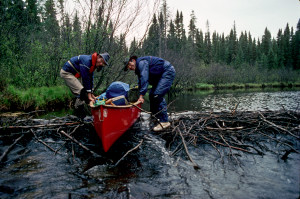 Walter and Rob stood on the dam and passed the Tripper between them to the other side. We followed suit with the Explorer. Much the same approach was required for the second dam. But we were able to propel both canoes over the third dam at ramming speed.
Walter and Rob stood on the dam and passed the Tripper between them to the other side. We followed suit with the Explorer. Much the same approach was required for the second dam. But we were able to propel both canoes over the third dam at ramming speed.
Along this stretch of river, the Explorer hung up a few times on sand bars and unexpected submerged rocks. At some point, Doug found the opportunity to fish some neoprene socks out of his river pack and put them on his feet inside the sneakers. It was also about this time that we discovered that the blade of the spare paddle from Canoe Sport was broken. For the rest of the trip this paddle just got in the way.
Rain continued to fall, and mosquitoes continued to swarm, although their ranks were thinned by the falling temperatures. At about 2:30 PM we stopped for lunch along a man made set of rapids created by rockfall from an adjacent railroad track.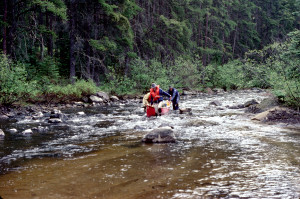 Rain had subsided to drizzle, and the temperature had dropped below 50° now, with a brisk wind making it seem colder. Lunch consisted of gouda cheese and summer sausage on bagel chips and Tuscany toast. Everyone supplied his own drink, mostly Gatorade in water purified with iodine tablets.
Rain had subsided to drizzle, and the temperature had dropped below 50° now, with a brisk wind making it seem colder. Lunch consisted of gouda cheese and summer sausage on bagel chips and Tuscany toast. Everyone supplied his own drink, mostly Gatorade in water purified with iodine tablets.
At one point, a Canadian Pacific passenger train passed. In a gesture symbolic of our disdain for civilization, Walter tossed the remaining summer sausage over his shoulder toward the train. The sausage landed in the bushes next to the track.
After lunch we decided to get photos of the two canoes running the rapids. I photographed Walter and Taylor passing through in the Tripper, with Walter in the stern. Then Walter came back to photograph the rest of us in the Explorer, with me in the stern. We bumped a few rocks, but made the run successfully.
Just downstream we passed under a bridge (the logging road to Biscotasing we had traversed 9 years ago) into a stretch of river that widened above Sultan Dam. Rob had joined us in the middle of the Explorer and had begun to fish with his Ozarks rattle trap lure. Almost immediately he caught a small pike, which he turned loose.
Soon afterwards we reached the dam. While Walter and Taylor reconnoitered the portage around the dam, we kept the Explorer out in the middle of the river where Rob could continue to fish. He hooked another pike, but it escaped before he could reel it in. After 10 minutes or so, Walter signaled us to come ashore. We portaged on the left from a marshy, mucky area, over another dirt road, down through undergrowth along a chain link fence. Then we paused to investigate and photograph some impressive falls and rapids over to the right of the dam.
Beyond the dam, we resumed our northward course through mostly marshy terrain. 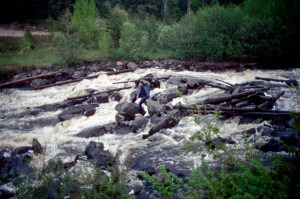 The temperature continued to drop, and we began having trouble with cold in the extremities. I started using the neoprene mitts I had purchased at a scuba diving shop in Dearborn. They made my hands warmer, but I found them slippery and inflexible, so that it was difficult to get a good grip on the paddle. I finally abandoned them because my hands were becoming too tired from the strain of trying to grip the paddle. Meanwhile my "stylish" hat, which I had purchased from Eddie Bauer after a considerable search, began to disintegrate. It lost its shape; it shrank to such an extent that it would no longer stay on my head; and the vinyl band around the crown worked itself loose and began flopping to the side whenever I bent over. In the space of a few hours I went from looking like Indiana Jones to looking like Freddy Krueger.
The temperature continued to drop, and we began having trouble with cold in the extremities. I started using the neoprene mitts I had purchased at a scuba diving shop in Dearborn. They made my hands warmer, but I found them slippery and inflexible, so that it was difficult to get a good grip on the paddle. I finally abandoned them because my hands were becoming too tired from the strain of trying to grip the paddle. Meanwhile my "stylish" hat, which I had purchased from Eddie Bauer after a considerable search, began to disintegrate. It lost its shape; it shrank to such an extent that it would no longer stay on my head; and the vinyl band around the crown worked itself loose and began flopping to the side whenever I bent over. In the space of a few hours I went from looking like Indiana Jones to looking like Freddy Krueger.
Shortly after 5:00 PM we came to our first long portage, which was actually two successive trails of 225 meters and one kilometer. The first trail started in a tangled thicket on the left bank of the river. It was poorly defined badly overgrown and hard to follow. Initially it headed uphill away from the river through dense undergrowth and over fallen trees. On our first pass with the gear, Doug straggled a bit and began to think he had wandered off the trail. He started calling out, "Hey, guys?!" until we reassured him we were just ahead in the underbrush. The trail then meandered back toward the river to what barely looked like a put in amidst bushes and marshy weeds.
We were tempted to launch the canoes here, but remarks on the Wakami River brochure suggested that we could continue through to the next trail. The reason soon became apparent. From this point, rocky rapids, interspersed with strainers on both sides of the river, extended to a shabby, makeshift dam/bridge supporting a narrow dirt road that supposedly ran into the little town of Sultan. At the dam, fallen trees and underbrush virtually obliterated the trail. We had to bushwhack a trail around the undergrowth to the dirt road. But on the other side of the road, the trail suddenly became distinct and easy to follow, suggesting that this might be the starting point for most people who attempt the Wakami River canoe route.
From the start of the portage I carried the Explorer to the end of the first trail; Doug carried it to the makeshift dam; and Taylor carried it to the end of the portage. Walter carried the Tripper to the end of the first trail. But then we decided to try running the rapids down to the makeshift dam. Walter and I launched the Tripper from the put in at the end of the first trail, with the kitchen pack in the middle of the canoe. We were immediately stymied by rocks and shallows.
We attributed our problems to the kitchen pack. This pack was an attempt to consolidate all our essential kitchen gear and accessories. Eventually it would prove to be an almost ideal way to keep these things organized and easily locatable. But it was by far the heaviest of our packs. We had dubbed it 'Hellpack II" in dubious homage to the smaller but equally murderous Hellpack of the White River trip 2 years earlier. The pack had handles on the side (for a two man carry) and Walter had tried to make the pack more manageable by putting rig straps on one end (for a more daunting one man backpack). But the poor condition of the trail made a two man carry almost impossible, and everyone was too tired now to backpack it. Our only recourse was to transport it in the canoe. But its weight apparently made the canoe heavy enough to catch on the rocks. We ended up having to walk the canoe through most of the rapids. Meanwhile, Doug waded along the shore, picking his way among the rocks and bushes in an effort to render assistance. He only succeeded in twisting his ankle. By the time we reached the makeshift dam, we were all exhausted.
We were also chilled to the bone. By the time me we reached the end of this portage, the temperature had dropped to the low 40's. It was still raining on and off, and the sky was so overcast that it looked as if dusk were already upon us, even though the time was only 7:30 PM. We discussed whether we wanted to press on or set up camp. There was enough room for both tents in a clearing at the end of the portage trail, and the presence of a fire ring indicated that people had camped here before. But Walter was reluctant to camp here because it was so close to civilization (Sultan). Finally we decided that civilization was not likely to visit us in weather like this, and at any rate we were too tired to go any further.
Setting up camp was difficult under such cold, wet, dreary conditions. The only thing going for us was the lack of bugs, which had apparently been chased away by the cold. While Doug and I set up the Overlander and Rob and Walter set up the Octadome, Taylor attempted a truly heroic feat: getting a fire started.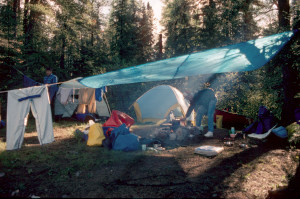 Since there was no dry firewood in sight, we were all amazed to turn around a few minutes later to find a fire crackling precariously but bravely in the fire ring. To improve the fire's odds of survival, Doug suggested that we put up a tarp over the kitchen area. With a tarp billowing overhead in the wind and a fire crackling stubbornly underneath, we all began to feel better. Walter left nothing to chance, though, and resorted to a bit of cognac to improve his frame of mind.
Since there was no dry firewood in sight, we were all amazed to turn around a few minutes later to find a fire crackling precariously but bravely in the fire ring. To improve the fire's odds of survival, Doug suggested that we put up a tarp over the kitchen area. With a tarp billowing overhead in the wind and a fire crackling stubbornly underneath, we all began to feel better. Walter left nothing to chance, though, and resorted to a bit of cognac to improve his frame of mind.
For a while I rallied enough to get dinner started the only time during the entire trip that I made dinner. I prevailed upon Walter to get the stove going, and we heated up enough water to make mountain chili and corn. The warm meal made a brief dent in the chill, but the temperature continued to drop into the 30's. The dampness made the fire somewhat smoky, and the wind kept changing direction, so that the smoke always seemed to be blowing in our faces and stinging our eyes.
The coup de grace was the snow. It started to fall unnoticed at first, making a slight pattering sound on the tarp. But soon it developed into wintry looking flakes that began to collect on our equipment. Everyone else decided to retire to the tents, which were still damp from the previous night's rain, but nevertheless offered some shelter from the cold wind and snow. I lingered outside for a short while, sifting through the stuff in my river pack in a dazed attempt to figure out what I needed to take into the tent. In this zombie like state, I was really able to appreciate the irony that I could freeze to death in June. Finally I adjourned to the tent. It was about 10:00 PM, and a thermometer on Doug's backpack registered 34°.
We fell asleep to the lightly rushing sound of upstream rapids and the surprising chirpy clamor of spring peepers, which seemed not at all deterred by the return of winter.
Monday, June 4
Chilly morning; running easy rapids; we negotiate an obstructed portage trail; lunch above the rapids; we run several challenging rapids; an ill-advised run; encounter with moose cow and calf; the Explorer hits a submerged rock; bushwhacking for an essential 400-meter portage trail; camp on a bluff in the marsh; the "bug shift" phenomenon; cold unrestful night.
By morning the snow had stopped, with little accumulation. The sky was still overcast, and the temperature was about 35°. Once again, Taylor was up first at about 7:00 AM to start a fire. Doug arose shortly afterwards to prepare coffee. Walter and Rob roused themselves at around 8:00. It was so cold and wet outside that I decided to stay in the tent for awhile to work on the log. When Doug brought me some coffee at about 9:00 (what service!), I decided I'd better get up and out. This decision was reinforced by Walter's pronouncement that we were going to break camp by 10:00 AM. Breakfast was the usual blueberry granola, but this time Rob introduced us to bagels toasted on the grill over the campfire. They were an instant hit!
We managed to break camp at around 10:15. I took the stern and Rob the bow of the Tripper. Doug took the stern and Taylor the bow of the Explorer. Walter sat in the middle of the Explorer the first time he was willing to part with the Tripper, and the only time he didn't paddle during the entire trip. Initially the canoeing was uneventful as we tried to warm up from the morning chill. We skipped the first two listed portages by running rapids. For the first, which supposedly required a 36-meter portage on the left, we were advised by the brochure to "take care not to be swept down rapids." But the rapids turned out to be so short and straightforward that we ran them with scarcely a second thought. The second rapids were supposed to require a longer portage (90 meters), but they too were easily runnable.
Then we came to a sharp bend in the river with steep rapids that could not be run. However, the 45-meter portage on the left was obliterated by fallen trees, and the only alternative route was blocked by trees too close together to permit passage of the canoes. We had to chop some of the lateral (now vertical) limbs away from the trunks of the fallen trees, then pass the canoes over the trunks a 3 man operation in each case because the trees were suspended over a pool of water spanned only by a treacherously slippery log.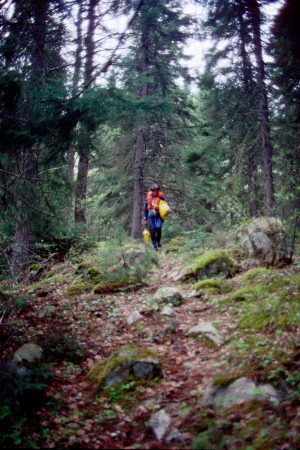 This portage took about twice as long as we expected.
This portage took about twice as long as we expected.
At about 2:00 PM we came to rapids that looked runnable, even though they were described as dangerous. We decided to stop for lunch while we considered whether or not to run them. We secured the canoes to the roots of a large uprooted tree on the left bank, then sat on a rocky promontory at the head of the rapids snacking on carroway and smoked gouda cheese with pita crisps and Tuscany toast and had peanut butter and chocolate chip granola bars for desert. Rob decided to fish below the rapids instead of joining us for lunch; so he grabbed his pole and tackle box and took off down the 270-meter portage trail. We eventually had to pack him a "box lunch" in the empty pita crisp bag. It was still somewhat overcast, but the day had warmed up enough for the bugs to be back out in force. In fact, the mosquitoes were joined for the first time by black flies. Fortunately, a sporadic breeze kept them from being too bothersome, and Doug felt unmenaced enough to take a short nap on the rocks.
When Rob returned from his unsuccessful fishing, we decided to go ahead and run the rapids. But first we reshuffled our canoe lineup. I took the bow and Walter the stern of the Tripper. Taylor took the bow, Rob the middle, and Doug the stern of the Explorer. We took the Tripper through first: skirted a strainer that extended out from the left bank, then ferried back left to avoid rocks along the right bank, then shot between two large boulders in the middle. The others followed in the Explorer after getting hung up in the strainer for a few minutes. Both canoes scraped the left boulder in the middle of the river as they shot through, but encountered no serious problems.
Shortly afterwards, we ran another set of rapids, avoiding a 70-meter portage on the left. We began to congratulate ourselves on how well we were doing running rapids. In some respects, though, we were becoming a bit overconfident failing to tie down the packs, for example. That overconfidence would soon be deflated.
We came to some rapids with a portage on the left. The portage was short (90 meters), but the next portage was directly across the river on the right side. While Doug, Taylor, and Rob completed portaging the Explorer and gear, Walter and I ferried over to the next portage to reconnoiter. This portage trail was also short (54 meters), although it went steeply up, then steeply down. After looking the rapids over carefully, we decided that we could run the upper portion, then ferry over to the right and line the canoes from there.
While the others waited impatiently in the Explorer, circling in a still pool above the rapids in a vain attempt to get clear of a cloud of black flies, Walter and I started our run in the Tripper. Halfway through it, we hung up suddenly on a pillow with less water over it than expected, lost control, and careened over to the center where all the rocks were. We managed to halt the canoe just short of a large boulder. I climbed out on the boulder to get some leverage for directing the canoe around its left side, but the current snatched the canoe away from me and left me stranded on the boulder. Meanwhile Walter tried to get the canoe past a whole crop of rocks just downstream, but it became tightly wedged among them. For a moment we were at a loss. With nothing better to do, I turned around on the boulder and waved sheepishly at our cohorts upstream. They promptly decided to portage. It become obvious that the only way out of our dilemma was for me to make my way back to the canoe so that we could walk it through to more open water. I slipped cautiously into the water and discovered to my surprise that it was not as deep, nor the current as strong, as I had expected. Wading over to the canoe, I walked it past the offending rocks, with Walter drawing and prying as needed, and clambered back into it when we were free. We completed the run with some awkwardness.
After this humiliating episode (which Rob was determined we would hear about for some time), we continued downstream through a narrow stretch of river with swift current and many strainers extending out from both sides. At one point we had to lift the canoes over two trees that had fallen completely across the river, side by side, creating a blockade.
Shortly afterwards we came unawares upon a cow moose and her calf lying in the brush along the left bank. We were startled when they suddenly stood up. At the time, Walter was just putting away his camera after changing film, and I was snacking on trail mix; so the Tripper was adrift backwards, and the Explorer had just passed it. At first, both moose moved way from us along the bank. But then the cow attempted to cross the river just ahead of the Explorer while the calf fled up into the woods. About halfway across the river, the cow suddenly seemed to realize the calf was not following.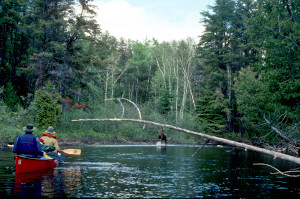 She turned to face the canoe, which raised concerns among the occupants that the moose might charge the boat. Faced with this threat, no one in the Explorer had his camera ready, and the moose quickly waded back to the left bank and lumbered off into the woods. Walter managed to snap a shot from farther away, but he had doubts about the quality of the photo. My back was turned to the whole spectacle; so I failed to see anything, though I heard all the commotion.
She turned to face the canoe, which raised concerns among the occupants that the moose might charge the boat. Faced with this threat, no one in the Explorer had his camera ready, and the moose quickly waded back to the left bank and lumbered off into the woods. Walter managed to snap a shot from farther away, but he had doubts about the quality of the photo. My back was turned to the whole spectacle; so I failed to see anything, though I heard all the commotion.
As we regrouped from this episode, we came upon some moderate rapids which we ran without incident. Just downstream from these rapids, however, the Explorer unexpectedly plowed into a submerged rock that brought it to a lurching halt. Rob skinned his knee, and his "box lunch" got soaked. Doug and Taylor were both shaken up but otherwise unhurt.
Less than 10 minutes later we came upon what appeared to be the same cow and calf we had encountered earlier. This time the two moose simply turned and departed, once again foregoing their photo opportunity. Initially we marveled that the mom had moved so far so quickly, but then we realized they must have traveled in a straight line while we were curving back and forth along the river and, of course, running into submerged rocks.
The weather was clearing up nicely now, with temperatures in the 60's and sunshine fairly consistent. At about 5:00 PM we came upon rapids for which the brochure indicated there was a 400-meter portage on the left. We guided the canoes to what looked like an obvious takeout, but we couldn't find a trail leading away from it. Rob and I climbed out of our respective canoes and bushwhacked along the left bank of the river down to a rather impressive chute, with a one meter falls passing under a downed tree. There was no way we could run this hazard. We then bushwhacked away from the river till we came across the missing trail. We followed the trail back to the real takeout, which turned out to be about 50 meters upstream from the spot where the canoes were waiting. The portage sign had fallen to the ground. (We had already encountered a few other downed portage signs and would encounter many others before the end of the trip. It became evident that either the route was not well traveled or Ontario's commitment to maintaining the route had faltered.) We shouted for the others to come back upstream, and they followed our voices accordingly. The portage turned out to be tough, with steep uphills and downhills, but the trail was attractive and easy to follow. Rob carried the Tripper halfway, and I completed the carry. Doug carried the Explorer, and Walter carried Hellpack.
From this point the terrain became marshy, with occasional oxbow lakes arching off in either direction. Walter and I can upon a couple of otters, who were poised high in the water making peculiar "puffing" noises at us. They quickly ducked under the water and swam away before the other canoe come within viewing range. A short time later the river diverged. Walter and I explored the left branch while the others proceeded down the right. The left branch became increasingly narrow and winding, but it showed no signs of ending. We decided it must be a creek and turned around.
When we caught up with the other canoe, they had paused at a rightward bend in the river near a rocky bluff on the left bank. Rob was fishing. The time was about 6:30 PM; so we asked whether the bluff looked like a good spot to set up camp. There were some doubts, largely because the surrounding area was so marshy and bug ridden. Walter decided to explore. He scaled the bluff, which rose about 5 meters above the river, but almost fell into the water as rocks along the bank gave way in the loose dirt. Down below I was under attack by veracious black flies, but up on the bluff Walter announced that the area was relatively bug free.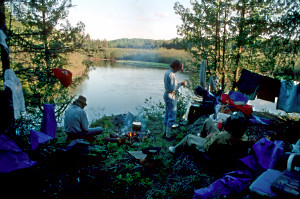 After a brief discussion, we decided to go with this campsite and take advantage of the clear weather and early halt to dry out our equipment.
After a brief discussion, we decided to go with this campsite and take advantage of the clear weather and early halt to dry out our equipment.
We had some difficulty finding a convenient place to dock and unload the canoes. Walter and I docked the Tripper against some angular rocks and struggled to unload as the canoe rocked and shifted. The others docked and unloaded the Explorer where the bank was more level, but also overgrown with scraggly bushes. Rather than pull the canoes out of the water, we simply tied them to shrubs and trees along the shore. Although the campsite was fairly open, there were enough obstacles and uneven spots to force us to make an appropriate sized clearing for the Overlander. After removing a number of rocks and bushes to free up space, we wedged the tent between a rocky hill and several trees. When the tents were erected, we tilted them to allow their floors to dry. Everything else we hung up on lines strung across several trees.
There was plenty of dry wood for a fire; so Taylor had no trouble getting one started. The water along the bank looked stagnant- so Taylor and I paddled out to the middle of the river in the Tripper to get cleaner looking water. When we returned, Rob prepared the dinner: Cajun rice with chicken and mixed garden vegetables. Dessert was cheese cake, which brought rave reviews. Taylor, Doug, and I washed and dried the dishes.
After I spotted a fish jumping out of the water, Rob tried some late fishing from the bluff, but with no luck. Then he went off into the woods in search of a good latrine. He returned a while later with tales of a magnificent, panoramic, bug free latrine that overlooked an oxbow lake on the other side of the hill on which we had made camp. Taylor immediately decided to take advantage of this find. He returned with the same glowing reports, which prompted Doug to follow suit. Afterwards, we all set around the campfire enjoying the nice weather.
It was here that we first really noticed the "bug shift" phenomenon. Because the weather was so clear now, the temperature dropped rapidly as the sun set. As the temperature dropped, we noticed that the mosquitoes "punched in" on the night shift just as the black flies "punched out". We could just imagine them at the punch clock exchanging pleasantries and work gossip ("Hey, Joe, be sure to try that big guy with the meaty legs!"). 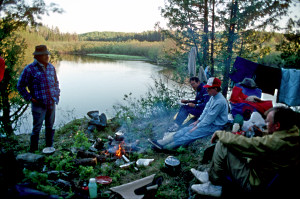 We were relieved, of course, to see the black flies go, but on this particular evening, as the temperature continued to fall, the mosquitoes soon disappeared, too. By the time the temperature had reached the mid 40's, we were bug free.
We were relieved, of course, to see the black flies go, but on this particular evening, as the temperature continued to fall, the mosquitoes soon disappeared, too. By the time the temperature had reached the mid 40's, we were bug free.
We tried to enjoy this freedom for awhile watching the full moonrise, listening to the ever present spring peepers, warming ourselves by the fire but eventually the fire no longer gave us sanctuary from the cold, and we fled into the tents. When we turned in at about 10:00 PM, the temperature was already in the low 40's. That night it continued to fall until it bottomed out below freezing. We spent most of the night shivering and sliding on the unlevel ground where our tents were pitched.
Tuesday, June 5
Morning activities; Little Ridout Lake; Rob has no fishing luck; encounter with fishermen; Ridout Lake; log obstruction and rapids; portage and lunch beside an impressive waterfall; lining through a tree-blocked rapid; Ransom Lake; the Explorer begins filling with water; another moose sighting; shooting rapids into Bayly Lake; peninsular campsite on Bayly Lake; repairing the damaged Explorer; dinner, bug extermination & filtering water; rain ends the evening.
Continuing a now well established custom, Taylor was up first at about 7:30AM to start the fire. Doug and I were up shortly afterwards, with Rob and Walter following suit around 8:00. Doug had a headache, apparently from the overnight cold. He didn't take anything for it on the assumption that it would go away once the air warmed up. Even with the sun up now, the temperature was still in the 30's under cloudless skies.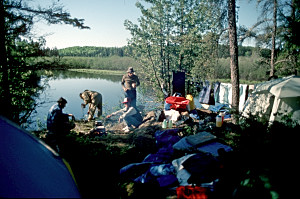 We immediately set about hanging up clothing, sleeping bags, etc.to dry off and air out. Despite the now dry weather, the inside walls of the tents tended to become damp overnight as the warm moisture from our bodies condensed on the cold fabric. We undoubtedly contributed to the problem by closing off the ventilation panels to ward off the cold.
We immediately set about hanging up clothing, sleeping bags, etc.to dry off and air out. Despite the now dry weather, the inside walls of the tents tended to become damp overnight as the warm moisture from our bodies condensed on the cold fabric. We undoubtedly contributed to the problem by closing off the ventilation panels to ward off the cold.
Rob tried fishing from the campsite for a while, but only snagged his rattle trap lure in the middle of the river. The two of us took the Tripper out to free the lure, then sat in the canoe while he fished for another 15 minutes. Still no luck. Meanwhile, Walter had started to prepare a Ranch Omelet with Beef for breakfast. Rob took over the cooking when we returned from fishing.
After breakfast, Walter went in search of the now legendary Panoramic Latrine. When he returned, he expressed concurrence with the others' favorable assessment, although he also revealed that the site was no longer bug free. I decided then to forego this memorable latrine. The air was warming up quickly now, and first the mosquitoes and then the black flies reappeared. We broke camp at about 10:30 AM, just as the black flies were becoming a real nuisance. By this time the temperature was already in the mid 50's.
We set out with Walter in the stern and Robin the bow of the Tripper. I was in the stern, Taylor the bow, and Doug the middle of the Explorer. The river continued to wind between low, scrubby bushes in marshy terrain with oxbow lakes and occasional rocky bluffs. In what would become a regular morning game, we looked for evidence of better campsites that we might have had if we had gone further the previous afternoon. Nothing looked very promising.
We were all ready to congratulate ourselves on having made the right camp decision when we reached Little Ridout Lake at about 11:30 AM. Then we spotted it: across the lake on a rocky promontory on the north shore was a magnificent campsite with wooden drying racks and a large cleared area swept by refreshing breezes. We paused there to survey longingly the campsite we might have had, then began to rationalize that the site looked too civilized. Meanwhile I took the opportunity to search for my own Panoramic Latrine. I had to "borrow" some kleenex from Rob because my own supply of toilet paper was buried in the bowels of my river pack. Upon my return, I offered to return the used sheets of kleenex, but Rob graciously declined.
When we were ready to get under way again, we switched positions so that Rob could fish. Walter and Doug were now in the Tripper; Rob, Taylor, and I were in the Explorer.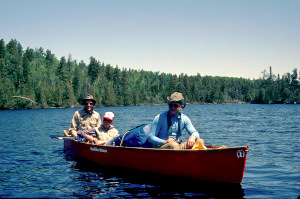 Over the next couple of hours Rob tried several lures, but with no luck. He did suffer several snags, but we managed to free them all with no loss of lures.
Over the next couple of hours Rob tried several lures, but with no luck. He did suffer several snags, but we managed to free them all with no loss of lures.
At about 12:30 PM we passed from Little Ridout Lake to Ridout Lake via a narrow channel with minor rapids. As we emerged from the rapids, we encountered two fishermen in a motor boat somewhat of a surprise, as we hadn't seen any people since Walter had tossed the summer sausage at the train two days before. We asked how the fishing was going; they replied that it had been better early in the morning.
Ridout Lake turned out to be broad, breezy, and beautiful, with stands of birch and spruce along its shores, broken by occasional rocky outcroppings, and dotted with small, wooded islands. We paddled through the lake at a leisurely pace, pausing from time to time to enjoy the scenery and nearly perfect weather and, of course, to help Rob free up his snags. We considered stopping somewhere for lunch, but decided to wait until we were back on the river, at least partly because swarms of black flies greeted us whenever we approached one of the islands. Eventually we reached the northeast end of the lake, where the Wakami River resumed its course.
At about 3:30 PM we came upon a log blockade at the head of some short rapids. We would have to pull the canoes over the blockade, then run the rapids on the left. Walter and Doug went first in the Tripper. Then, while we were pulling the Explorer over the log, they made their way over to the right bank so that Walter could reconnoiter. The brochure indicated a waterfall in the vicinity, and the sound of rushing water seemed to be coming from just around a bend to the right. Walter bushwhacked his way across the peninsula to the top of the falls, then spotted the portage on the opposite bank just short of the falls. These falls turned out to be the most powerful and impressive we had yet encountered. The river curved around to the left, then plunged at least 20 meters in two downward steps of wildly churning white water. Walter and Doug ferried over to the formally designated portage takeout, which appeared dangerously close to swift water leading into the falls. The rest of us decided to take out about 20 meters farther upstream, much to the annoyance of Walter, who kept shouting that there was plenty of room for two canoes at the formal takeout point. The portage trail itself was relatively short (117 meters) and easy to follow, although it dropped precipitously down rocks alongside the falls. I carried the Explorer down to the end of the trail. Walter carried the Tripper to a rocky bluff near the top of the falls. 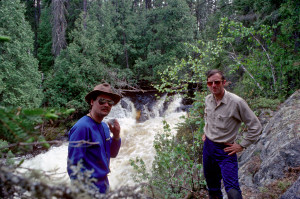 There we decided to have lunch.
There we decided to have lunch.
At this point the sky was starting to cloud over, and the temperature was around 70°. There was some breeze, but not enough to chase away squadrons of black flies and mosquitoes We snacked on the usual gouda cheese, summer sausage, pita crisps, and Tuscany toast, washing it all down with Gatorade. Then we hung around the falls for a while taking photos from various angles, trying in vain to capture the raw power of the violently plunging water. The time was approaching 5:00 PM when we finally continued on our way.
Under way again, we began to look for some rapids which the brochure described as having a 37-meter portage on the left, but they never materialized. At about 5:30 we came upon short rapids where the river forged through a narrow, rocky chute. The rapids themselves looked runnable, but a large white cedar lay across the chute, making a safe run impossible. There was some speculation that this log might have been put here deliberately, perhaps as a means of preventing some kind of accident during lower water levels. (By this time we had concluded that the water level was 1 2 meters higher than normal for this time of year.) The portage trail on the right was only 54 meters, but it was a real mess, and we weren't in the mood for portaging; so we decided to try lining the canoes through the right side of the chute beneath the felled tree. After some awkward scrambling about with ropes among the brush along the right bank, we managed to get both canoes through safely, although we heard a loud "crack" as the Explorer swung around into a large tree stump just after clearing the rapids.
When we were ready to get underway again, Taylor complained that his shoulder was really sore. Rob offered to forego any further fishing for the day in order to relieve him in the bow of the Explorer. He gladly accepted the offer and spent the reminder of the afternoon in the middle of the Explorer. Just down river from the chute we passed through some minor rapids into Ransom Lake, a long convoluted body of water with marshy shores and some shallow, reedy spots.
It was on Ransom Lake that I first noticed the alarming quantity of water in the bottom of the Explorer. I couldn't recall passing through any standing waves that would have dumped so much water into the canoe. I suggested that Taylor try to bail out some of the water to see what the effect would be. When he had bailed for 20 minutes with little effect, we knew we had a problem. We couldn't see any leaks, but much of the bottom of the canoe was obscured by the river packs and other gear. We decided that Taylor should keep bailing until we made camp, where we'd be able to take a close look at any damage to the canoe.
At the eastern end of Ransom Lake we passed again into the Wakami River via some more minor rapids, foregoing a 54-meter portage on the right. The terrain was still somewhat marshy, with reeds and scrubby bushes along the banks. As Walter and Doug passed the mouth of a small reedy inlet on the right, they spotted a moose back up in the inlet. When they swerved into the inlet to take a closer look, the moose fled into the woods. The rest of us in the Explorer were far enough behind that we never really saw anything, although we did hear the crackle and crash in the underbrush as the moose retreated through the woods.
At about 6:30 PM we reached a set of rapids where the river emptied into Bayly Lake. A short way into the rapids there was a large boulder right in the middle of the river that obscured our view of the rest of the rapids below. Walter and Doug entered the rapids just to the right of the boulder, then eddy turned in behind it to survey the downstream portion of the rapids. Walter announced that they would continue right through the middle of the rapids between two pillows, but he suggested that we pass to the left of the large boulder and continue downstream on the left side to avoid the pillows altogether. He and Doug then did a peel out and continued their run without incident. We followed Walter's advice, but were not able to get over as far left as we wanted. Even so, we suffered no more than a slight bump as we grazed the pillow on the left.
As the rapids slingshot us out into Bayly Lake, we noticed that two fishermen in a small motorboat had just reeled in a rather fat looking walleye. Rob was itching to tryout this fishing spot. But at this point we were anxious to find a campsite, not only because of the leaking canoe, but also because the sky had completely clouded over now and seemed to be threatening rain. Rob noted the kind of lure they were using in case he had the opportunity to come back to this spot later.
Bayly Lake was quite a lot like Ridout Lake, with stands of birch and spruce along the shores, occasional rocky outcroppings, and scattered wooded islands. We were looking for one of the established campsites indicated in the Wakami River brochure. At about 7:00 we came upon a rocky peninsula jutting out from the west side of the lake supposedly the location of an established campsite. Walter investigated and quickly pronounced it "a keeper". When the rest of us come ashore, we agreed. There was plenty of room for the tents, good access to water, easy takeout for the canoes, a fire ring with plenty of dry firewood, including already cut logs, well spaced trees for stringing up clothesline, and even a crude little table for preparing food. The only drawback was the bugs. But by now we had come to the conclusion that in this region at this time of year there was no such thing as a bug free campsite as long as the temperature was above 45°.
The peninsula itself seemed almost like a rocky island separated from the mainland by a low lying marshy area covered with scrubby bushes. Although we set up camp on the very tip of the peninsula, there was room for more tents, and even other kitchen areas, farther in toward the mainland. Walter and Rob weren't especially happy at our choice of a tent site: right in front of their planned site. But we were just trying to be neighborly... and also trying to avoid camping all the way on the other side of the peninsula. 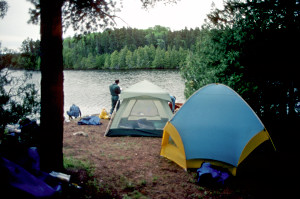 Meanwhile, Doug took a couple of the Tylenol capsules I had brought along. His headache had been with him all day long, even after the morning chill had departed. The Tylenol seemed to help enough that he soon afterwards broke out a bottle of Asti Spumanti so that we could all toast the fact that we had now reached the halfway point of the trip.
Meanwhile, Doug took a couple of the Tylenol capsules I had brought along. His headache had been with him all day long, even after the morning chill had departed. The Tylenol seemed to help enough that he soon afterwards broke out a bottle of Asti Spumanti so that we could all toast the fact that we had now reached the halfway point of the trip.
Next we turned our attention to a more sobering matter: checking the Explorer for damage. The source of the leakage was obvious once the gear was removed. There were break through gashes on both sides of the canoe just about at the waterline. There were also some even nastier looking gashes on the outside bottom of the canoe, but these had not broken through because of the extra layers of kevlar that reinforced the hull. We were really concerned now that the canoe might be too fragile to make it through the rest of the trip. But the immediate problem was to stop the leakage. First I plugged both the gashes inside and out with some rubbery old Bond Aid glue from my Thermarest repair kit. Then Taylor sealed the plug inside and out with strips of Walter's duct tape. The repairs looked as if they would work, but we wouldn't know for sure until we had paddled the canoe for a ways the following day.
By this time dinner preparations were under way. Rob whipped up a dinner of Chicken a la King and green peas, with peaches and cream pie for desert. Meanwhile we attempted to prepare the tents for bug free sleeping that night. We closed up both tents and lighted PIC insect exterminator rings in them. Unfortunately, we didn't allow enough time for the exterminator to work, and in any case, many of the bugs took refuge in the screen windows of the tents, just outside the closed flaps, but ready to come in for a feast as soon as the flaps were opened.
At about this time, Taylor demonstrated his water filter to us. We were impressed at how clear it got the water, with none of the brownish hue and peculiar aftertaste of the water we had been purifying with iodine tablets. The only problem with it was that it required substantial muscle power to purify relatively small amounts of water. As the filter became clogged with filtrates, the required effort only increased. After trying out the filter over the next few days, we all came to the conclusion that we'd like a filter in the same price range (about $45), but with some kind of lever to reduce the amount of effort.
Because this was the nicest campsite we had yet encountered, we really wanted to enjoy it -sitting around the campfire talking about the trip, swapping stories and jokes, reminiscing about previous trips, discussing philosophy, art, politics, or whatever. Unfortunately, the weather refused to cooperate. The rain started at about 9:00 PM just a drizzle at first, but gradually picking up as darkness came. We considered putting up the tarp, but decided it was probably more effort then it was worth. As much as we wanted to enjoy the campfire, we were all pretty tired. Rob, Taylor, and Doug decided to retire for the night. Walter and I stubbornly hung around the campfire in the drizzle trying to strike up a good discussion, but as the rain picked up, we realized it was a lost cause and finally decided to join our comrades in the tents.
The rain continued on and off all night, but it never really became all that heavy. A wind sprang up, though, and the temperature dropped into the upper 40's.
Wednesday, June 6
Morning fishing excursion; the "Curse of the Bagel"; extensive scouting and some misguiding along the rapids back to the Wakami River; more scouting and a short, messy portage trail; more rapid running and a close encounter of the bad kind for the Explorer; and more rapids and portaging; lunch on the rocks; logging bridge; doused by rain; tricky run at the remains of an old logging bridge; peninsula portage; confluence of the Woman River; another rocky campsite above a marsh; cool evening; bug vs. human casualty report.
For a change, I was the first up, awaking at about 6:30 AM. I decided to work on the log in the tent, but my mechanical pencil ran out of lead. I had to get dressed to go search for replacement lead in my ditty bag, which was buried in my riverpack outside the tent.
The weather was cool, wet, overcast, and windy, but the rain had ceased. In the absence of bugs, I briefly entertained the notion of going "swimming" to get cleaned up, but decided it was too cold and windy. As I resumed working on the log outside the tent, Rob popped out of the other tent and announced that he wanted to go fishing back at the rapids emptying into Bayly Lake. The distance was about a mile; the wind was now subsiding -and the possibility of fish for breakfast made me a reasonably willing accomplice in this proposed venture. Besides, I thought, this fishing foray would give us a chance to test the repair job on the Explorer.
We set off at about 7:00 AM, planning to return no later then 8:30. We reached the rapids in about 20 minutes and positioned the canoe in an eddy next to the same current by which we had first entered the lake. I "anchored" the canoe to this eddy by resting my foot on a boulder just upstream from the eddy. Rob fished for about 45 minutes. He started out with a leech lure similar to the one the fishermen had used to catch their walleye the previous afternoon. No luck. He then switched to his "Erie Dearie" lure. That did the trick: He reeled in a 1.5 pound walleye. While we fished, the sun peeked through the clouds several times, giving us hope that the day might turnout nice. For the most part, the morning was already fairly pleasant. At first I had some misgivings about not having brought along the log to work on, or at least Rob's other fishing pole to join in the fishing. But it was fun just to relax in beautiful surroundings, chatting idly with Rob and maneuvering the canoe from time to time to free up snags.
With no further catches, we departed just before 8:00 and arrived bark at camp at around 8: 15. Breakfast preparations were already under way, but to the usual blueberry granola and bagels we were able to add pan fried fillet of walleye! 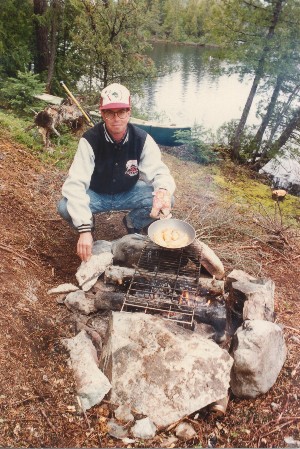 The canoe repairs had held up admirably, and I began to feel more confident about the Explorer's ability to make it out of the wilderness.
The canoe repairs had held up admirably, and I began to feel more confident about the Explorer's ability to make it out of the wilderness.
It was about this time, however, that we were visited with the "Curse of the Bagel". As I was taking a bagel over to the fire to toast it, I slipped on a wet, mossy rock and landed hard on the old gluteus maximus. Half the bagel went flying out into the lake and floated away like an abandoned life preserver. The other half landed in the dirt. My butt was sore for the rest of the trip. Shortly afterwards, Walter cut his finger while trying to slice a bagel in half. He had to repair the damage with a bandaid. Then Taylor almost cut his finger the same way and ended up with his bagel in the dirt. At the time it almost most seemed like a curse, but in retrospect it was more like a comedy of errors.
We managed to break camp at 9:45, the earliest yet! It was still overcast and somewhat windy, but there was no sign of further rain. The temperature was in the 50's. Although the repairs to the Explorer seemed to be working, we decided to improve the odds by reducing the load in that canoe. From this point on, the Tripper became the 3 man man canoe, and the Explorer was limited to 2. We started out with Walter in the bow of the Tripper, Taylor in the stern, and Rob fishing in the middle. I took the bow and Doug the stern of the Explorer.
Out in Bayly Lake, Rob caught a pike almost immediately, but it was too small to keep. The lake gradually narrowed and gave way to a succession of "lakelets" connected by narrow channels. Navigation became somewhat more confusing, and Walter had to consult his maps and compass on a regular basis. The sky began to clear up somewhat. Large white and dark clouds alternated with blue sky and occasional sun. The day began to take on an almost autumnal mood.
At about 10:30AM we came to rapids that marked the outlet of Bayly Lake back into the Wakami River. According to the brochure, we were supposed to be able to walk the canoes through these rapids, but the water looked too high and the current too strong. On the other hand, the rapids were too long to run without scouting. We pulled over to a portage take out on the left and carried some of the packs to the end of the 220-meter trail. From below the rapids we could see some pretty mean ledges and pillows. Rob returned up the trail to the canoes while the rest of us bushwhacked back upstream a ways along the bank, with Walter in the lead. The view from the bank was still inconclusive. Walter then "led" us back inland, overshot the portage trail, and continued into the bush, followed by Taylor and Doug. I was at the tail end of this procession. As I crossed the portage trail, I asked, "Hey, doesn't the trail go this way?" and turned to the left, assuming that everyone would follow. Fifty meters down the trail I realized no one was following me. When I reached the canoes, Rob asked where everyone else was. I could only shrug my shoulders and describe what had just transpired. I could see that Rob was going to have a field day on this one. When the rest of the crew returned about 10 minutes later, Walter already somewhat red faced had to endure Rob's patented merciless needling. Rob expounded at length on the fact that this wild goose chase had been led by the very person who had been goading us to keep on schedule. Eventually we got back to the business at hand and decided just to complete the portage rather then trying to run the rapids.
At about 11:30 we came to a set of rapids that, according to the brochure, could be walked through on the right side. The rapids were extensive enough that we decided to pull over to the right bank to reconnoiter. To get to the bank, however, we had to pull the canoes over some logs that formed a blockade just outside the portage takeout. Walter started to scout the rapids. His initial assessment was that the water was too high for us to walk the canoes through, but that the rapids might be runnable. But then we decided it would be easier just to go ahead and portage the canoes rather then pull them back over the logs to get to a runnable position in the river. The trail was relatively short, put it was really a mess at the end: muddy, with many fallen or leaning dead trees and thick undergrowth. As we wrestled the canoes through the mess, the black flies rang the dinner bell. They were with us in force the rest of the day as the temperatures climbed into the 60's.
At this point, Doug and I switched positions in the Explorer, and Walter and Taylor switched positions in the Tripper. Not long afterwards we encountered another set of rapids that we were supposed to be able to walk through. The water level was high again, but these rapids were more modest, and we ran them on the left side with little scouting.
The next set of rapids came close to being a Waterloo for the Explorer. The Tripper pulled over to the left bank and Walter got out to reconnoiter. After climbing out onto a strainer to get a better view, he decided the rapids were runnable. He and Taylor proceeded to ferry the Tripper back to the center, enter the rapids at the V in the center, then follow the big water over to the left, way from some rather large boulders extending out from the right bank. Doug and I followed soon after, but we started too far to the right of the V, got our signals mixed trying to adjust, ended up too close to the center of the lower rapids, and barely passed between a deadly pillow on the left and a large boulder on the right. We were extremely lucky. On this one occasion the river was somewhat forgiving of our mistakes.
Not long afterwards we passed through a reverse S shaped set of rapids with substantial waves but no apparent rock obstacles. The Wakami brochure again described this stretch as a potential "walk through," but the abundant water made it easily runnable. Just beyond these rapids we came to a more formidable set of rapids, with lots of white water kicking up down below. From upstream the rapids looked runnable, but we decided we'd better pull over to the portage trail on the left to reconnoiter. Once on the portage trail, we found there was no easy way to get over to the bank where we could scout the rapids. We decided to forget about running the rapids and just complete the portage. The portage trail was in pretty good shape, but trees had fallen across the trail at waist height in two separate spots; so we found it easiest just to double carry the canoes.
From here the river began to open up into a more lake like stretch flanked by large stands of birch. At about 2:30 PM we spotted a rocky, open area along the left bank that looked breezy enough for us to have lunch without too much aggravation from the black flies.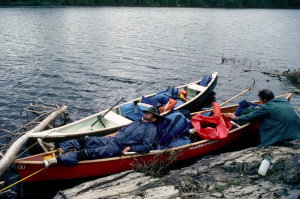 Lunch was pretty familiar: gouda cheese, sesame edam cheese, bagel crisps, Tuscany toast. But instead of summer sausage, spicy meat sticks were introduced. The breeze helped with the black flies, but not much.
Lunch was pretty familiar: gouda cheese, sesame edam cheese, bagel crisps, Tuscany toast. But instead of summer sausage, spicy meat sticks were introduced. The breeze helped with the black flies, but not much.
Taylor was continuing to have problems with his shoulder; so he traded the bow position in the Tripper to Rob and took the middle. As we resumed our northward course, we noticed a clearcut area off to the left away from the shore. Evidently loggers had made their mark here in a big way.
The river narrowed again, and a large dark cloud passed over, sprinkling us with light rain. Then suddenly the sun came out in full force. We warmed up so quickly from the radiant heat that we all started to strip down to cool off. Soon afterward we came to a bridge crossed by a logging road. Rocks from the bridge construction had created minor rapids underneath the bridge, but the V was wide enough for both canoes to pass through at the same time. Just after we passed under the bridge, a red pickup truck crossed it, and the occupants honked and waved at us. We declined to wave back and tried to ignore this intrusion of civilization.
At about 4:00 the sky clouded over completely, and we had heavy rain for about 20 minutes. Everyone was thoroughly soaked, especially Rob, whose rain gear was buried in his river pack. Walter was dismayed to find that the crotch of his rain suit leaked. He was rather uncomfortable for most of the rest of the afternoon.
The rain subsided just as we came upon an ancient logging bridge over some rapids. Only two of its spanning logs were still in place, but the abutments, with their neatly dovetailed logs, were still well preserved, and there was one pylon in the middle partially obscured by a large boulder. The Tripper put into shore on the left bank, and Walter climbed up the abutment to scout the rapids. A fallen white cedar extended out from the left bank just past the boulder, ruling out a straight run to the left of the boulder. But the remaining pylon was in the center, and there were too many rocks on the right The only course was to sweep past the right side of the boulder, then swing back across to the left just past the cedar but just before the pylon. The run required some tricky maneuvering,but the current was not too strong and seemed to be flowing more or less naturally the way we wanted to go.
The Tripper ran through first without incident, although Rob was rather complacently sitting up on his seat in the bow instead of kneeling down (a few well chosen expletives from Walter brought him to his knees midway through the run). In the Explorer, Doug and I made it OK past the right side of the boulder, but then we swung too for to the left and ended up almost broadside to the current and in danger of plowing into some rocks on the left bank. Some quick adjustments brought us back around just in time, so that we only grazed a shelf on the left formed by a submerged log. We were somewhat pleased with ourselves for having salvaged a potentially disastrous run, but Rob waxed eloquent about how clumsy we looked.
Three miles of flatwater paddling followed. Then we came to rapids with much bigger water a chute with high standing waves.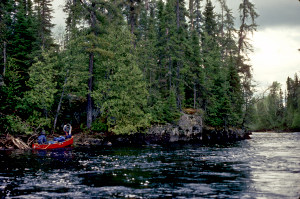 The rapids looked runnable, but not with fully loaded canoes. We considered running the canoes after portaging the packs, but decided to press on and just portage the canoes. The portage trail was not long, and it arched over a peninsula formed by a sharp rightward bend in the river. There was a campsite just off the trail, but it was heavily littered and not very attractive.
The rapids looked runnable, but not with fully loaded canoes. We considered running the canoes after portaging the packs, but decided to press on and just portage the canoes. The portage trail was not long, and it arched over a peninsula formed by a sharp rightward bend in the river. There was a campsite just off the trail, but it was heavily littered and not very attractive.
At this point the river straightened out and seemed to flow in exactly the same direction the wind was blowing. The wind picked up, and we playfully used our paddles to catch the breeze and "sail" down the river. The sky was clearing up again, and the weather was very pleasant, especially with the wind behind us. At one point we saw what appeared to be otters or muskrats in the water.
Just after 5:30 PM we came to the confluence of the Wakami and Woman rivers. We bid farewell to the Wakami and embarked on the Woman amidst various jokes and songs about women. Rob thought the confluence of the two rivers would be a good place to fish, but since he was in the bow, he couldn't indulge. His best hope was for us to find a campsite nearby, so that he could return later, or in the morning, to fish for awhile. Within l0 minutes we came upon a campsite on the left bank with a nice supply of freshly cut wood. Walter checked it out, but rejected it when he spotted fresh ATV tracks leading into the area via a crude logging road/trail.
About 20 minutes later we came upon another potential campsite at a bend in the river. 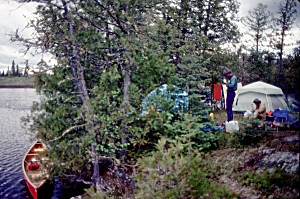 The bend formed a rounded point of higher, wooded land across from mostly marshy terrain. Walter and I checked out the site, but weren't especially happy with it. There was a slight breeze, but the bugs were pretty bad. The site reminded us somewhat of our Monday campsite. Walter pointed out that we were not likely to find a much better campsite this afternoon, but he and I were both willing to press on for another 3 4 miles. Everyone else wanted to set up camp and start drying things out, though, and when I spotted what looked like a great latrine, I changed my mind and decided the site was OK.
The bend formed a rounded point of higher, wooded land across from mostly marshy terrain. Walter and I checked out the site, but weren't especially happy with it. There was a slight breeze, but the bugs were pretty bad. The site reminded us somewhat of our Monday campsite. Walter pointed out that we were not likely to find a much better campsite this afternoon, but he and I were both willing to press on for another 3 4 miles. Everyone else wanted to set up camp and start drying things out, though, and when I spotted what looked like a great latrine, I changed my mind and decided the site was OK.
With the site agreed upon, we docked and unloaded the canoes on a rocky "step" at water's edge. Rob and Walter immediately claimed the best tent site, leaving the rest of us to clear a sloping area of rocks, stumps, and small anthills. They also lighted up some PIC in Walter's tent as soon as it was erected. We opted instead to air out the Overlander, which was still damp from rain the previous night. The tent soon acquired a bumper crop of black flies and mosquitoes.
There was no established fire ring; so we made one out of the rocks we cleared from our tent site. Surprisingly, there was a small quantity of cut wood, somewhat damp, but easily dried by the fire. Taylor and I started up the fire, then Rob began preparing the meal. Dinner tonight was Shrimp Cantonese, peas and carrots, and apple cobbler for desert. During dinner I had a chance to try out Walter's new camp chair, which was designed to fold up so tightly that it could fit into a backpack. It looked flimsy and awkward, but it turned out to be incredibly comfortable. It also turned out to be dauntingly expensive.
After dinner, Rob tried fishing right from the campsite, but with little expectation of success. The weather was clearing up again. Large cloud banks rolled over us, but there was no threat of rain. As the sun set, the clouds pretty much disappeared, and the temperature began to drop rapidly, in much the same fashion as Monday night. It looked as if we were in for another frigid evening, but the temperature eventually bottomed out in the mid 40's still within our comfort range.
The cooling air chased away most of the bugs except the ones in our tent. Being able to sit around the campfire free of bugs was a real blessing. By now our party was pretty well bitten up. Walter and Doug complained especially about the bites on their legs, and Rob seemed to be developing an extensive rash from the bug bites, the insect repellent, or both.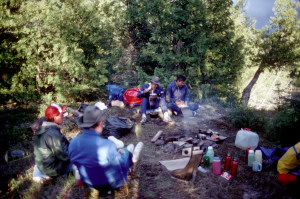 Only Taylor and I seemed to be holding up reasonably well in this primordial battle of man vs. bug.
Only Taylor and I seemed to be holding up reasonably well in this primordial battle of man vs. bug.
Nevertheless, when we were ready to turn in at about 10:00 PM, we had to launch our version of the Blitz, sweeping the "skies" with our flashlights as we spotted and dispatched dozens of mosquitoes and flies on the interior walls of the tent. We could hear Walter and Rob over in their PIC protected tent chuckling at our distress.
I had some difficulty finding a comfortable sleeping position because my butt still ached from the Curse of the Bagel. Eventually we all fell asleep to the usual raucous chorus of spring peepers. But once again, the annoying slope of the tent site woke us up from time to time during the night. We were also disturbed by the occasional whine of mosquitoes apparent survivors of the Blitz. No doubt those mosquitoes dined well that night.
Thursday, June 7
The finer points of wilderness toiletry; down the Woman River; long-abandoned logging operations; multiple portages around waterfalls; another moose sighting and a missed joke; snack break below the falls; swimming moose; Rob enters "Walleye Heaven"; confluence of the Opeepeesway River; another moose encounter; a lengthy and contested fresh fish lunch by the falls; running through standing waves plus a fly-infested portage trail; Rush River; campsite considerations; running more rapids; cramped campsite at the start of a 600-meter portage around falls; nighttime visit to the falls; pleasant evening around the campfire.
I awoke at 7:00 AM to work on the log. Taylor and Doug got up and left the tent shortly afterwards to air out their sleeping bags and other equipment on the line. We all expected Rob to get up early to go fishing back at the confluence of the Wakami and Woman (less then a mile upstream), but there was no sign of life in the Octadome.
The sky was cloudless, and the temperature was in the mid 40's. By the time Rob and Walter roused themselves, Taylor had a fire going. Breakfast was the usual blueberry granola and bagels, but grape jelly was now introduced as a bagel topping.
After breakfast, in sporadic succession, each voyageur wandered off into the surrounding scraggly woods for what had now become a morning ritual. The great latrine I had spotted when we first landed turned out to be too close to camp for adequate privacy. Alternatives were located, but nothing approached the legendary Panoramic Latrine. By this time me we had all perfected various "shake rattle and roll" techniques for avoiding bug bites in sensitive spots while in our states of singular vulnerability. Even so, the best defense was to find a latrine before the bugs did, or least before they found us. Another, somewhat unexpected, defense turned out to be the food we were eating. It seemed to be high enough in fiber content to make our solid wastes somewhat less than solid. Doug expressed some concern about this until we pointed out that quick evacuation reduced the time of exposure to the little beasties.
We broke camp this morning at about 10:20 AM. The sun was shining brightly as temperatures rose near 60°. For only the second time on the trip, Walter agreed to part with the Tripper and tryout the Explorer. He took stern, and Doug took bow. Taylor took bow and I took stern in the Tripper, while Rob fished from the middle.
We embarked on our first full day on the Woman River. Along this initial stretch of the river, and at various points during the day, we noticed evidence of logging operations long abandoned: skeletal cabins, rusty oil drum stoves, dilapidated docks, etc. Fortunately, there was no indication of any current logging activity, and we were pleased to find ourselves completely alone on a beautiful river in superb weather.
Within a half hour we arrived at the first of a whole succession of portages. This first portage was rather typical of the rest of the day: a short (35 meters) trail on the right around some falls. We double carried both canoes.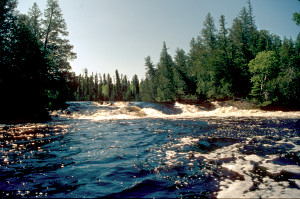 A short time later we encountered a 64-meter portage on the left, again around some falls, and again we double carried the canoes.
A short time later we encountered a 64-meter portage on the left, again around some falls, and again we double carried the canoes.
Unlike the rapids on the Wakami, which were mostly runnable (at least with unloaded canoe), the rapids on the Woman would largely be falls of sufficient force and magnitude as to make open canoeing unthinkable. Based on what we knew of the Woman from the Sakatawi trip, and based on Walter's careful scrutiny of the topographical maps, we pretty much anticipated having to portage at every set of rapids, and as a result, our portaging became more efficient as the day wore on. We continued to be hampered, though, by the fact that most portage points could not accommodate two canoes at once. The routine became: dock one canoe; remove the equipment and place it off the trail out of the way; pull the canoe out of the water and portage it immediately; then return to portage the equipment while the other canoe goes through the same routine; reload the first canoe and launch it; then reload the second and launch it.
Now that the Explorer carried a lighter load (including only two men), it was faster and therefore usually in the lead both on the water and in and out of the portages. Shortly after the second portage, Walter and Doug spotted a moose cow and two calves in the woods on a hillside above the river. The moose casually ambled out of sight. At the time, the rest of us were well behind and preoccupied with one of Rob's infamous off color jokes. So we missed the moose, and Walter and Doug missed the joke. However, Rob was kind enough to update them on the punchline (but not the lead up) at the next portage.
This portage was about 220 meters around the right of some more falls.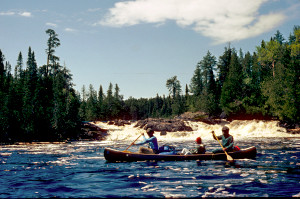 At the end of the portage trail was the most beautiful campsite we encountered on the whole trip: nicely shaded, but open, elevated, breezy, and relatively bug free, with a magnificent view of the falls, plenty of level ground for tents, and a well made fire ring surrounded by logs for good seating. We all sighed that we hadn't come this far the night before. We considered having lunch here, but decided it was too early (only 12:20 PM). Instead, we pushed off into the pool below the rapids and enjoyed trail mix and drink while Rob fished in the swirling water. Walter and Doug played around a bit, maneuvering the Explorer through currents and eddies to get some closer photos of the falls. Then we all set off down the river.
At the end of the portage trail was the most beautiful campsite we encountered on the whole trip: nicely shaded, but open, elevated, breezy, and relatively bug free, with a magnificent view of the falls, plenty of level ground for tents, and a well made fire ring surrounded by logs for good seating. We all sighed that we hadn't come this far the night before. We considered having lunch here, but decided it was too early (only 12:20 PM). Instead, we pushed off into the pool below the rapids and enjoyed trail mix and drink while Rob fished in the swirling water. Walter and Doug played around a bit, maneuvering the Explorer through currents and eddies to get some closer photos of the falls. Then we all set off down the river.
The high wooded and rocky banks gradually gave way to more open, marshy land. Just before 1:00 PM we came upon a large moose (apparently a bull, but without antlers) that had just entered the river from an area of low bushes and reeds on the left bank. Walter and Doug were close enough to the animal that we expected it to turn around and head back for the left bank. Instead, it swam all the way across the river, right in front of the canoe, and disappeared into a small oxbow lake behind bushes and reeds on the right bank.
While our attention was diverted to the moose, Rob hooked his first walleye of the day about 1.5 pounds. He was elated enough with this catch, but during the next 45 minutes he caught three more walleyes, ranging from 1 1/2 to 2.5 pounds. With each catch, Rob grew progressively more excited, until he was almost in a state of euphoria. We were all somewhat puzzled as to why this stretch of river would be so good for fishing. We eventually dubbed it "Walleye Heaven". In his rapture, Rob bubbled about how quickly and easily he could fillet, bread, and pan fry these fish for lunch, if only we could convince Walter to go along with it. We decided not to broach the subject until we reached the next portage, which would probably be a good place to stop for lunch. Besides, Walter and Doug were too far ahead of us anyway, and we couldn't catch up to them with the stringer of fish dangling in the water creating a splashing drag on the progress of the canoe.
While we struggled to keep up, we missed two "events" that were observed by occupants of the lead canoe. First, we passed through the confluence of the Wakami and Opeepeesway rivers. The Opeepeesway River flows from Opeepeesway Lake, where nine years ago we had found an island that turned out to be the best campsite of our Sakatawi trip. When we passed the confluence, we in the trailing canoe didn't really notice it. Because of the marshy terrain, the Opeepeesway seemed like just another elongated oxbow lake, and we had no maps in the canoe to tell us otherwise.
Second, Walter and Doug came upon another moose browsing in the water along the shore. It swam around a "corner" of bushes and reeds, then ran up the bank into some woods before those of us in the trailing canoe were even aware of it. By this time we were all somewhat amazed at our many moose encounters. On the Sakatawi and White River trips, we had seen moose tracks and moose scat, but no moose. We began to hypothesize that the very reason we had previously avoided this time of year (early June) was the reason the moose were out along the river: black flies. Apparently the moose were trying to escape the little beasties in the only manner available to them by swimming out in the water.
Eventually, Walter and Doug paused long enough for us to catch up so that we could discuss lunch plans. This was the right time to bring up the matter of a fish lunch. Walter's initial reaction was predictably negative...and realistic: it would take too much time to prepare the fish for lunch; we should hold off on it till we made camp, and then have the fish for dinner. 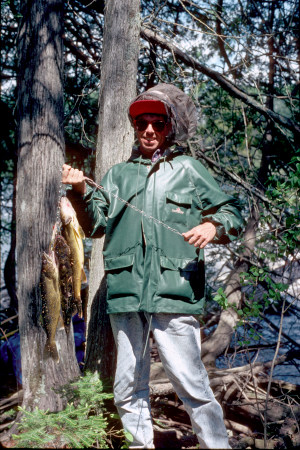 But the rest of us were completely sold on the idea of fish for lunch, not only because we all love fresh fish, but because the prospect of carrying a bunch of dying and increasingly odoriferous fish through several portages did not appeal to anyone. Finally, Walter relented, and we stopped for a fish lunch at the next portage.
But the rest of us were completely sold on the idea of fish for lunch, not only because we all love fresh fish, but because the prospect of carrying a bunch of dying and increasingly odoriferous fish through several portages did not appeal to anyone. Finally, Walter relented, and we stopped for a fish lunch at the next portage.
This portage was 37 meters around the left side of some falls. The take out point was perilously close to the falls, and we had to take care not to get caught in the current as we angled over to shore. The time was about 2:30 PM. It was a great place to have lunch except for the black flies. Rob started to set up shop for preparing the fish, but Walter seemed a bit perturbed about his choice of location: right where we were planning to eat. "You're not going to do that here, are you?" he asked rhetorically. After the usual Rob Walter exchange of contrary opinions, Rob transferred his operation to a rocky, brushy, fly infested area at water's edge just below the falls. After such good luck fishing, nothing was going to spoil his festive mood. Using a canoe paddle as a cutting board, he filleted each fish as it continued to flip flop in futile efforts to get away. No one could ask for fresher fillets! He then dipped each fillet in Shake and Bake and fried it in a pan of Wesson oil heated upon Walter's portable stove. The whole operation took longer then even Walter expected, but it was well worth the time and effort. Afterwards, we all paid our compliments to the chef for the best meal of the trip.
While we were waiting for lunch, I decided to try an experiment. The falls were bifurcated by a large jumble of rocks, which forced the river apart enough so that two separate torrents crashed back together just below, creating enormous standing waves. I found a large, canoe shaped piece of driftwood and tossed it into the water just above the falls. After passing quickly to the left of the rocks, it was violently wrenched about by the right torrent, then shoved under the standing waves. It finally reappeared above water about 20 meters downstream.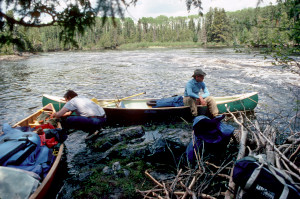 I could just imagine what would have happened to a canoe, or even a kayak, under such conditions a chilling thought, even on this warm day!
I could just imagine what would have happened to a canoe, or even a kayak, under such conditions a chilling thought, even on this warm day!
At about 4:00 PM we resumed our trip. Within a half mile we came to some rapids with large standing waves.Walter got out of the canoe to reconnoiter from the left bank. He could find no sign of a portage trail; so we decided to run the rapids. The run was straightforward, but we needed to pull over to a portage on the leftimmediately after the standing waves to avoid being swept down some falls. The portage featured a 127-meter trail that went steeply uphill, then almost as steeply back downhill. The black flies here were the worst we had yet encountered. We loaded and launched the Tripper at breakneck speed in a frenzied effort to escape the littlebeasties.
When we were at last far enough down the river for the slight breeze to have blown away some of the flies, we looked around and realized that the Explorer was well behind us, despite having launched before us. Apparently Walter and Doug had gone around a "bend" in the river just below the falls to take some photos. The bend turned out to be the Rush River, which flowed into the Woman from the south at that point. We were now on the same stretch of the Woman River that we had canoed 9 years ago! The rest of the trip would be through "familiar" territory.
It was now almost 5:30 PM. We continued down a long stretch of beautiful river with high banks and heavily wooded shores. The sky was turning increasingly cloudy, but the clouds were white and fluffy, and the sun was still shining warmly. At about 6:30 we came to another set of falls with a 135-meter portage on the left. About 50 meters down the trail, the portage was obstructed by a large fallen spruce. We paused for Taylor to go back for ax and saw, but then I decided, somewhat foolishly, to press on through the scraggly branches without waiting. I paid for my impatience with scratched hands, and a bit farther down the trail I slipped on a wet moss covered rock and hurt my knee. This portage was turning out to be a real trial for me.
At the end of the portage trail, Walter and I recognized some familiar rocky landmarks from 9 years before, and we noticed how much higher the river was now than it had been then at least 2 3 meters higher. Because the time was almost 7:00 PM, Walter thought we should stop here and set up camp. The site was just below some falls, so we'd have a good source of running (i.e. non stagnant) water, and we could expect to fall asleep that night to the pleasant sound of rushing water. There was plenty of firewood and although there was no fire ring, we could easily build a fire on a rocky outcropping by the water.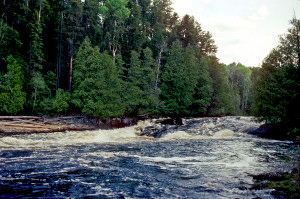 There were problems, though. The bugs were almost intolerable, and the situation of the campsite was such that there would be no breeze to blow them way. More importantly, there was no really clear, level area to pitch our tents. We'd have to clear away logs and debris, and then strip away or mat down large numbers of scrubby bushes and weeds. Even so, Walter was reluctant to abandon this site because he couldn't recall any better campsites further down the river. The rest of us insisted on pressing on, though, and he finally conceded to our majority vote.
There were problems, though. The bugs were almost intolerable, and the situation of the campsite was such that there would be no breeze to blow them way. More importantly, there was no really clear, level area to pitch our tents. We'd have to clear away logs and debris, and then strip away or mat down large numbers of scrubby bushes and weeds. Even so, Walter was reluctant to abandon this site because he couldn't recall any better campsites further down the river. The rest of us insisted on pressing on, though, and he finally conceded to our majority vote.
Shortly after we launched the canoes, we noticed another potential campsite on the northeast shore of a lake-like expanse of river just below the falls. But Walter and Doug, who were well ahead of us in the Explorer, continued past it without pause, and we learned later that they had rejected the site because they thought the slope was too steep for pitching the tents.
Soon afterwards we came upon two sets of rapids along a stretch of river that curved around to the left. We ran both rapids through high standing waves. Great fun! Then we arrived at our next portage, a 600-meter trail around the right of a whole series of rapids leading up to falls. At the head of this trail was a well established campsite with fire ring and tent clearing. We decided to stop here for the night. The time was about 7:30.
The campsite was somewhat close and cramped, and there was a big anthill next to the fire ring. Piles of moose scat littered the ground on the fringes of the site, on the portage trail leading out of it to the north, and on another trail leading back upriver to the south. But the site was pleasantly shaded and within easy earshot of the first set of rapids. Also, we recalled this portage trail as being the most beautiful we encountered on the Sakatawi trip. We were looking forward to hiking down the trail after dinner to view the falls near trail's end.
We pitched the tents very close to each other just in front of the southward trail. We had to clear away some of the moose scat to make room for the Overlander. Then we ventured a ways down the portage trail to collect dry wood so that Taylor could startup a fire. Rob whipped up a dinner of Chicken a la King and peas, with spring vegetable noodle soup as an appetizer. Dessert was mocha moose pie, another real crowd pleaser.
As the sun set, the sky became virtually cloudless again. The bugs were still pretty bad, although the black flies, as usual, gradually yielded to the mosquitoes as dusk settled in. This time me we set off PIC in both tents as soon as they were erected. After dinner, we stowed the gear, food, etc. Then Walter and Rob went down the portage trail to look at the falls. Taylor and Doug stayed behind to wash dishes. They decided to wait till the following morning to visit the falls.
After making some notes in the log, I decided to join Walter and Rob at the falls. For the first time since Wakami Lake, I broke out the Coleman spotlight for use on the now dark trail. In the darkness I found the trail somewhat harder to follow than I had expected. In spots it seemed more swampy and overgrown than I remembered. Initially I walked past the falls, almost to the very end of the trail, then doubled back and homed in on Walter's flashlight which I could just barely make out down by the falls. The falls themselves were even more impressive than I remembered. The higher water crashed violently through the narrow chute with even greater force than 9 years before. The three of us sat by the raging water until 10:30 reminiscing about the Sakatawi trip We also played with our flashlights, making strange patterns of light on the spruce thickets across the way. We were somewhat surprised at the power and range of my spotlight.
On the way back from the falls, Rob picked up some antlers he had found earlier on the trail. We assumed they were moose antlers, but we didn't rule out deer or even elk. Later (at the Wakami Store) we confirmed that they had come from a moose.
Back in camp we revived the fire and sat around it until almost midnight sipping camp coffee spiked with amaretto, reviewing the events of the day.and especially talking about other trips we might want to take in the future (e.g. Sand River). 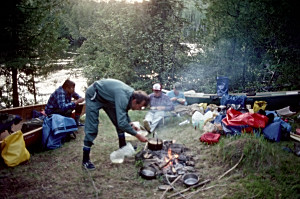 At one point I reached for my spotlight to again demonstrate its power, only to discover that the battery had gone dead. The spotlight was rechargeable, of course, but the nearest place to plug it in was probably in Foleyet. I was dismayed that it held a charge for such a short time, but I was also relieved that it hadn't died on the trail.
At one point I reached for my spotlight to again demonstrate its power, only to discover that the battery had gone dead. The spotlight was rechargeable, of course, but the nearest place to plug it in was probably in Foleyet. I was dismayed that it held a charge for such a short time, but I was also relieved that it hadn't died on the trail.
As we sat around the campfire, we were amazed to find that the bugs had virtually disappeared, even though the temperature was still in the 50's. Doug decided to hit the sack at 11:30. He reported from the tent that the PIC had done its work: we would have a bug free night of sleeping!
This day turned out to be the highpoint of the trip. The weather was almost perfect the whole day, though somewhat warm at times in the afternoon. Rob had his best day ever at fishing finally justifying the $30 fishing license. It was the culinary apex of the trip, with fresh fish for lunch. The scenery was beautiful, with waterfall after waterfall reminiscent of the White River trip. We saw 5 moose on 3 occasions, but no other people. We were finally able to spend some quality time around the campfire free of bugs, rain, and cold. And we had the best sleeping conditions yet: bug free, comfortable temperatures, relatively level ground, and the restful murmur of rushing water nearby, broken only by loon calls from time to time. To quote the beer ad, "it doesn't get any better than this."
Friday, June 8
Jim's omelet mishap; tree-cramped portage around the falls; scouting and running rapids above Horwood Falls; double portage around Horwood Falls; lunch at Horwood Falls; easy trip up the lake; Rob loses his headnet; uneven campsite on Blueberry Island; pre-dinner baths; "Toxic Sock Syndrome"; bug-induced maladies; buzzed by boating bozos; rainy, sleepless night.
Everyone was up at around 7:00 AM to air out sleeping bags, take morning constitutionals, and get breakfast started. The sky was still cloudless, and the temperature was in the low to mid 40's. Despite the chilly morning air, Taylor decided to take a "wipe bath" using a washcloth which he dipped in the river.
We wanted to get an early start on this long portage, so we had no campfire this morning. Instead, we used Doug's portable stove for the first time since Sunday. Breakfast was granola bars and cheese omelet. I was the last to get any omelet; so I decided to eat it straight out of the pan. But the handle of the pan collapsed (as it is designed to do for packing purposes), and my omelet fell on the ground. Fortunately for me, I had split the last bagel with Doug; so I didn't go hungry.
We broke camp at around 8:45 AM. As had been evident in the dark the night before, the portage trail was in disrepair, with many fallen spruce trees making it seem overgrown. Taylor went ahead with an ax: to clear away any branches that might block the canoes. The rest of us finished packing, then headed down the trail after him with river packs and other gear. Taylor returned and carried the Explorer as far as a swampy section of the trail with black muck and small, slippery logs laid side by side in a kind of "catwalk". There he was relieved by Walter. 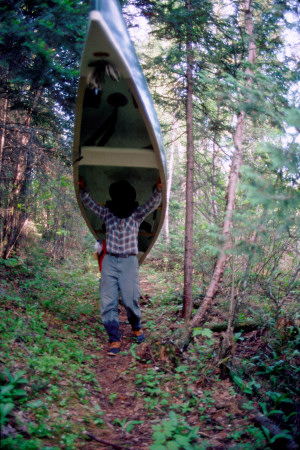 I carried the Tripper for about 500 meters, from the campsite to a section of the trail with trees too close together for passage of the canoe. There I was relieved by Walter, who had run into the same problem carrying the Explorer. In both cases the canoes had to be turned sideways and dragged between the tree trunks. When the portage was completed, everyone except Rob went back to the falls to take photos. Rob stayed behind to fish from the bank just below the falls. While we were scampering around the falls in search of the best angles for photos, I came across a really interesting piece of driftwood, which I carried back to the canoes and wedged into one of the gear bags.
I carried the Tripper for about 500 meters, from the campsite to a section of the trail with trees too close together for passage of the canoe. There I was relieved by Walter, who had run into the same problem carrying the Explorer. In both cases the canoes had to be turned sideways and dragged between the tree trunks. When the portage was completed, everyone except Rob went back to the falls to take photos. Rob stayed behind to fish from the bank just below the falls. While we were scampering around the falls in search of the best angles for photos, I came across a really interesting piece of driftwood, which I carried back to the canoes and wedged into one of the gear bags.
By 10:00 AM we were ready to get under way. Doug took the bow and I took the stern of the Explorer. Rob took the bow and Walter the stern of the Tripper, with Taylor in the middle. Less than a half mile down the river we encountered rapids. We had run these same rapids 9 years earlier, but there was considerably more water in them now. We pulled over to a large rock on the right, and Walter hopped out to scout the rapids. He edged precariously across a log extending from the rock to the shore, then spent several minutes surveying the rapids from a vantage point farther downstream. As he returned across the log, we gave him an appropriate drumroll on the side of the canoes. The plan was to run the left side of the rapids through large standing waves into the middle of the river, then angle back over to the left to reach the portage around Horwood Falls. Both canoes made the run successfully, although the bowmen managed to get pretty wet.
The portage was billed as 630 meters, but it actually consisted of two portages divided by a short float down a small creek. The first portage trail went steeply uphill, then back down to the creek. Doug carried the Tripper, Walter the Explorer. As we reloaded the Explorer, I managed to slip into the creek up to my waist. By this time the temperature had reached the upper 60's, though; so the dunk felt refreshing.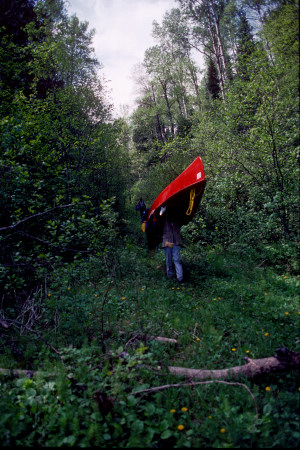 The creek itself had considerably more water and fewer obstructions than it had 9 years before. As we paddled upstream in the sluggish current, we were able to pull the canoes over some logs and to push others (including the makings of a beaver dam) out of the way. We soon reached our take out point near the abandoned, dilapidated carcass of an old logging cabin.
The creek itself had considerably more water and fewer obstructions than it had 9 years before. As we paddled upstream in the sluggish current, we were able to pull the canoes over some logs and to push others (including the makings of a beaver dam) out of the way. We soon reached our take out point near the abandoned, dilapidated carcass of an old logging cabin.
The second portage trail ascended through the woods to the crest of a hill along which ran an old overgrown logging road. Crossing the road, it then descended rather steeply to Lake Horwood. Rob carried the Explorer while the rest of us carried most of the equipment down to the lake. As we descended toward the lake, we were dismayed to see several motor boats out in the water. On the return trip, I carried the Tripper to the lake while everyone else ventured down the logging road toward Horwood Falls. By the tine I had finished the portage and retrieved my camera, they were on their way back up the road complaining that they hadn't been able to see anything. I decided then to pass on the side trip.
By 12:30 PM we had reloaded the canoes and were ready to embark on Horwood Lake. Rob and Taylor exchanged places in the Tripper, so that Rob could fish. Walter immediately piloted the Tripper over near the falls to get some photos while Doug and I loaded and launched the Explorer. Horwood Falls are actually divided by a kind of island into left falls and right falls. The right falls look more impressive from the lake than the left falls. After a brief pass in front of both, Doug and I docked by some rocks to the left of the left falls, and I scrambled up the almost sheer rock face to get a better view. From there I could see that the left falls were really just the spillway from a large churning pool just below some even more impressive falls. These falls were "behind" the island and therefore not visible from the lake, but they were higher and more powerful than the right falls visible from the lake.
Doug and I hung around the area for a while taking pictures. Eventually the rest of the crew came over to investigate. It was about 12:30 PM, too early to stop for lunch. Yet this spot was so scenic, and we had set out so early that morning, that we decided to go ahead and take an early lunch break here. While the food was being unpacked and brought up from the Tripper, I noticed that Doug was working his way around the edge of the pool toward the falls.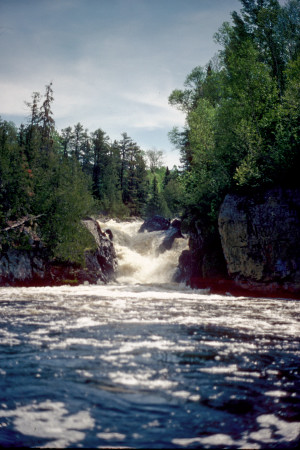 I grabbed my camera and followed. Although I did not see him again (he apparently returned via a different route), I had no trouble making my way up to the falls. From there the full power of the cascading water could be felt, and the view was even more breathtaking then from below. I took at least a dozen pictures trying in vain to capture this majestic spectacle. Then I explored what looked like a trail leading off through the woods on the left. This trail soon petered out but left me in a spot from which I could easily return to the canoes.
I grabbed my camera and followed. Although I did not see him again (he apparently returned via a different route), I had no trouble making my way up to the falls. From there the full power of the cascading water could be felt, and the view was even more breathtaking then from below. I took at least a dozen pictures trying in vain to capture this majestic spectacle. Then I explored what looked like a trail leading off through the woods on the left. This trail soon petered out but left me in a spot from which I could easily return to the canoes.
When I rejoined the group, they were snacking on peanut butter and grape jelly on Melba toast, Tuscany toast, and granola bars. Doug and I spoke enthusiastically about the great view up next to the falls, but no one else seemed interested. Apparently everyone was either too tired or too disappointed with the earlier trek down the logging road to go bushwhacking up to the falls.
As we were reloading the food pack in the Tripper, the trash bag tipped over, spilling discarded food pouches into the water. The trash quickly floated away in the current. The Tripper had to be launched immediately on a trash pickup detail. As soon as the trash had been reclaimed and the kitchen pack secured, we were ready to continue up Horwood Lake. It was about 1:00 PM.
The trip up Horwood Lake was a pleasant surprise. Unlike the trip 9 years before, we had the wind behind us and, at least at the start, fair weather. The only problem we encountered was the disruptive wake of an occasional passing motorboat. Every hour or so we paused to take our bearings, to snack on trail mix, to drink Crystal Light, and to discuss our plans for the remaining portion of the trip. By 2:30 PM we were making such good progress (about 4 mph) that we realized we'd be able to reach the Aerostar by 6:00 PM. 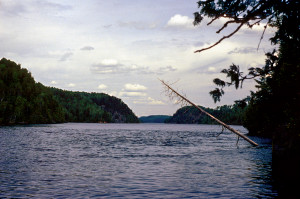 If we wanted, we could end the trip that afternoon.
If we wanted, we could end the trip that afternoon.
No one really wanted to end the trip a day early, and we didn't particularly relish the prospect of driving back to Wakami Lake in the evening. After all, where would we stay? And if we tried heading back to Michigan, we'd be driving over unfamiliar Canadian roads in the dark while completely exhausted. On the other hand, clouds were rolling in now, and eventually the sky was completely clouded over, with some darker clouds threatening rain. No one really wanted to spend another night in a soggy tent.
We discussed the options for some time before we decided on a plan. Our plan was to stop that afternoon several miles short of the Aerostar and set up camp on an island or breezy point on the lake. The next morning we would finish the trip and then have most of the day for our return home. If the weather deteriorated markedly, or if it looked as if there were danger of our being wind bound the next day, we would finish the trip that evening and spend the night in a motel, probably in Chapleau.
At one point we stopped in the middle of the lake to allow Rob and Taylor to get their rain gear out of their river packs, which happened to be in the Explorer. We found that we could steady both canoes in the wavy lake by pulling them alongside each other and holding them together by the gunwales, creating a kind of pontoon boat. Rob continued to fish throughout the trip up Horwood Lake, but with no luck.
At about 4:00 we started seriously looking for a campsite. Walter checked out one peninsula where he thought we had visited a campsite during our Sakatawi trip, but he could find no usable site. Apparently we had already passed the campsite he remembered. From this peninsula we paddled out across choppy water toward a medium sized, oblong shaped island in the middle of the lake (on the map it was called "Blueberry Island"). Doug and I headed toward the far (southern) end of the island, tacking almost directly into the wind, with the intention of coming about quickly at that end, then coasting back the length of the island with the wind behind us. We thought that would allow us to inspect the island closely without having to worry about the wind and waves. Walter and Taylor took a more direct approach, but as the Tripper neared the island, Rob's headnet suddenly blew off into the water and immediately sank without a trace. Walter brought the Tripper around to go after the headnet, but by then it was too late.
It didn't take long for us to locate an acceptable campsite at the northern end of the island. The campsite needed to be cleaned up, though: lots of dead fallen spruce were scattered about. But there was a nice fire ring, fair access to water, and enough of a breeze to keep the bugs at bay. We had some trouble locating good spots for the tents, though. For one thing, the whole island seemed to be solid rock laminated with a thin coating of moss and lichens. We were amazed that any trees could grow there, yet there was an abundance of spruce.
But the big problem was lack of level ground. When we first came ashore, Walter had proceeded to relieve himself at a relatively level spot on a hill toward the other side of the island from the fire re ring. At the time we joked, "Hey, that's where we were planning to pitch our tent!" Walter and Rob then claimed what was probably the best spot for a tent, not far from the fire ring and kitchen area. The rest of us had to chop small trees, uproot bushes and weeds, move spruce logs and brush, and remove several nasty looking rocks to make room for the Overlander nearby. Even then, the site was on such a slant that we wondered if we should look for another spot. Walter helpfully suggested an alternative spot: the same spot where he had relieved himself when we had first come ashore. We were not amused, but the spot become known as "Urinary Hill".
While Taylor started a fire, and Rob prepared dinner, I decided to take a "bath". Bugs were scarce enough for me to remove my shirt. I then jumped into the lake with my surf sneakers and trousers on and a small bottle of biodegradable soap in my hand. The water was cold, but refreshing. The floor of the lake, however, was algae covered rock so slippery and uneven that I had trouble keeping upright while I soaped down my body and shampooed my hair. After diving under water to rinse off, I struggled back up on the shore to dry off and change into warm, dry clothes. When I announced how much better I felt after this "bath", Doug decided to follow suit. Everyone else was too tired or too leery of the cold water to try it.
As I hung up my trousers on the clothesline after my bath, I noticed a nauseating smell in the vicinity. At first I thought there must be a dead animal under foot, but eventually I determined that it was Walter's socks hanging nearby on the same line. Walter tried to explain that these socks were made of polypropylene, and polypro socks are infamous for their odor. But I was wearing polypro socks of my own, and they never smelled like that. I promptly dubbed the phenomenon "Toxic Sock Syndrome". Walter dispatched the socks to a plastic bag, presumably to let Christy deal with them at a later time.
Fortunately no one's appetite was spoiled by toxic sock syndrome, but the dinner itself would eventually produce an unpleasant syndrome of its own. Dinner for the evening was Country Beef and Been Casserole, Green Peas and Onions, and Pineapple Cheesecake. It was the combination of beans and onions that was to cause such devastating malaise later that evening.
As the meal was nearing completion, light rain began falling intermittently.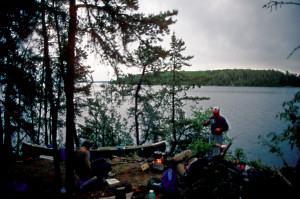 Fortunately the wind had died down; so we decided to put up the tarp over the kitchen area. This turned out to be a wise decision because the rain soon became more steady. On the other hand, the wind also picked up, causing the tarp to billow up like a parachute and flop wildly in the breeze. We tried to stabilize it by throwing a log on top, but the wind whipped tarp just tossed the log off the way a bucking bronco discards a hapless cowboy. Finally, we used some extra rope to anchor the forward edge of the tarp to a pile of logs on the ground. The tarp continued to flap noisily, but at least we and the fire were protected from the rain.
Fortunately the wind had died down; so we decided to put up the tarp over the kitchen area. This turned out to be a wise decision because the rain soon became more steady. On the other hand, the wind also picked up, causing the tarp to billow up like a parachute and flop wildly in the breeze. We tried to stabilize it by throwing a log on top, but the wind whipped tarp just tossed the log off the way a bucking bronco discards a hapless cowboy. Finally, we used some extra rope to anchor the forward edge of the tarp to a pile of logs on the ground. The tarp continued to flap noisily, but at least we and the fire were protected from the rain.
Ironically, the bugs, which had mysteriously disappeared when the wind died down, now just as inexplicably reappeared to join us under the flapping tarp. We all sat around complaining about our bug bites, our allergic reactions to the bug dope, and our aching muscles from the hard paddle up Horwood Lake. Rob was apparently allergic to Muskol. He had developed a rash over much of his body. Taylor was still having trouble with his aching shoulders. Walter and Doug were plagued by bug bites. In my case, my eyes were bleary from the Avon Skin So Soft the stuff seemed to discourage the black flies, but it also caused my eyes to swell and tear up. My back ached because my sore knee had forced me to paddle while sitting up instead of kneeling down. We were all pretty much ready to call it a day and, perhaps also, ready for the trip to end.
We turned in for the night at about 9:00 the earliest of the trip. It was raining; the fire had gone out; there wasn't really anything to do; and we planned to get up at 6:00 the next morning. It was about this time that three bozos in a small motorboat buzzed the island. We thought they were probably drunk and out joy riding. At first we were just annoyed, but when they came back a second time, cutting their motor to make a closer pass, we grew somewhat concerned. Apparently their curiosity was satisfied, though, because they left without returning.
At about 1:00 PM the rain turned into a steady, soaking downpour, which continued through much of the night. We all had trouble sleeping because of the sloping tent floors and the deadly "bunion gas" (from the beans and onions at dinner).
Saturday, June 9
Early rise to a soggy camp; paddling up Horwood Lake; anxious search for the landing; back on the road; Rob buys a shower; completion of automobile arrangements; we take the long road south.
At about 3:30AM Walter woke up to a powerful thirst caused by consumption of after dinner cognac. In keeping with the immutable law of camping ("Whatever you need will be farthest away."), he had to go out in the rain to find something to drink. Soon afterwards the rain subsided, but the wind suddenly sprang up again, causing the tarp to flap wildly and noisily. For a brief period, loons could be heard calling to each other across the lake.
As dawn approached, a nearby bird starting singing with a strange and somewhat complicated series of calls. At first I found the song interesting, but after a while it became maddeningly repetitious. After struggling to sleep on uneven ground all night, I finally gave up and left the tent at about 5:30 AM. Everything was soggy, including anything that had been left along the inside walls of the tent. The Tripper had two inches of rainwater in it.
The bunion gas made me feel like a dirigible about to explode; so I ventured down toward the other end of the he island seeking relief. When I returned, Taylor was up preparing blueberry granola for breakfast. He had an odd look of determination in his eyes. After adopting a pretty much laid back attitude for most of the trip, he suddenly began to push hard for our departure. It reminded me of the way runners start to sprint when they move into the home stretch of a race.
The rest of the crew got up around 6:00, and Rob and Walter set off for different areas of the island for their morning constitutionals. After a quick breakfast, we broke camp at record speed and were ready to depart by about 7:25 AM. Luck was still with us. The wind was still blowing from the south; so we would have it behind us for the duration of the trip.
We set out with the same crews as the previous day. Rob continued to fish, but apparently Horwood Lake was devoid of hungry fish. Several times we paused for Walter to take our bearings. Once we had begun to head down what appeared on the map to be the correct arm of the lake, Doug and I became somewhat concerned at the unfamiliar landmarks. After we passed a large island with two fingers jutting to the south, I thought we should be able to see the boat launch where we had left the Aerostar, but there was no sign of it.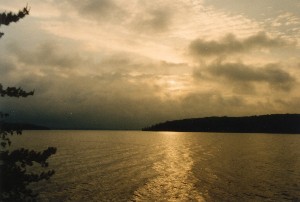 On the other hand, we could see a jumble of cottages, a marina, and Horwood Dam none of which we had been able to see from the boat launch. By this time,everyone was growing worried.
On the other hand, we could see a jumble of cottages, a marina, and Horwood Dam none of which we had been able to see from the boat launch. By this time,everyone was growing worried.
Finally, at about 8:45, we spotted the boat launch. Apparently, when we had parked the Aerostar, a line of trees to the north had obscured our view of the cabins, the marina, and the dam. With relief, we docked at a logjam on the side of the boat launch and began unloading the canoes. As we transferred the canoes and gear from the lake to the Aerostar, we watched some Canadians loading a backhoe and some heavy lumber onto a raft consisting of wooden beams laid between two aluminum boats and supported by oil barrels. These guys were planning to build a cabin out on some island in Horwood Lake. We wished them well and said good bye to Horwood Lake.
The dirt road out to Route 101 seemed shorter and smoother than Doug and I remembered on our trip in. We speculated that the road might have been graded in the interim. By 10:00 AM we were back at the Petrol Canada station outside Chapleau. We noticed that here, and later at theWakami Store, the black flies were just terrible. Everyone tried calling home from a telephone booth outside the station, but without success. We wanted to let our families know we'd be in Ypsilanti by around midnight that evening. Finally, Doug managed to get through by calling collect with the assistance of an operator. After that, everyone got through except Walter. Taylor spoke with Beth after having to convince Lisa to accept the charges. I spoke with Peter. Rob left a message on his answering machine.
At around 11:00 we reached the Wakami Store, where Rob decided to take a shower for $5. We left him there while we continued on toWakami Lake to get the Lincoln. There we transferred some of the load from the Aerostar to the Lincoln. Then we departed, with Walter and me in the Lincoln, Taylor and Doug in the Aerostar. We ate lunch on the move the remaining peanut butter and smoked gouda cheese on Melba toast. Pausing briefly at the Wakami Store to pick up Rob in the Aerostar, we headed west on Route 667, then south on Route 129, then west again on Route 17.
Walter and I listened to cassettes of lusty medieval music as we drove along in the Lincoln. Eventually we stopped at a service station in Bruce Mines, a small town along Route 17 not far from the North Channel of Lake Huron. There Walter tried to call home, again without success. I had a headache; so I bought some aspirin and a jug of orange juice. Walter relieved me at the wheel and drove all the way to Mackinaw City in Michigan, where Doug stopped for gas and Taylor took over driving the Lincoln. Walter finally managed to call home and learned that in his absence a tornado had touched down near his neighborhood.
Earlier, as we crossed the Mackinac Bridge, I had popped in a cassette recording of Vaughan Williams' Sea Symphony featuring a rousing sea chantey adapted to lyrics from Walt Whitman's "Leaves of Grass":
Today a rude, brief recitative
Of ships sailing the seas,
Each with its special flag or ship signal,
Of unnamed heroes in the ships,
Of waves spreading and spreading
Far as the eye can reach,
Of dashing spray
And winds biting and blowing....
Somehow this passage seemed a fitting tribute to our voyage, especially with the blue Straits of Mackinac spreading out below us. Another tribute was waiting for us in Flint several hours later. As we passed by the airport on the freeway, we could see a magnificent fireworks display off to the west.
We arrived in Ypsilanti at around 11:30 PM, transferred the Tripper to Walter's Toyota van, pumped him and Rob up with coffee, and sent them on their way. They reached home at around 5:00 AM the following morning. Doug and I arranged to meet the next day at Canoe Sport to return the Explorer.
Sunday, June 10
Explorer damage cost; second thoughts about using a kevlar canoe; positive trip assessment.
When we returned the canoe, everyone expressed concern about the damage. However, no one was in an immediate position to estimate the cost of repairs. Canoe Sport assured us the cost would be as little as required to get the canoe ready for rental again; so we were hoping it wouldn't be much more then $100.
It wasn't until the end of June that we were informed of the cost: $300! This was well above the original $200 rental! At first we were taken aback, but after some discussion, Doug, Taylor, and I accepted the estimate, conceding that the damage might well require as much as 10 15 hours of labor to repair at a reasonable $20 per hour.
We had some misgivings, of course, about our decision to take the Explorer on the trip in the first place. When Taylor had originally inquired about renting a canoe, Canoe Sport had offered him an ABS canoe. When we subsequently discovered that we could get a kevlar canoe for the same rental fee, we had switched to the kevlar because we thought it would be even stronger then the ABS (after all, bullet proof vests are made of kevlar). Kevlar had the additional advantages of being faster in the water and lighter on the portage trail. We had no reason to suspect that this canoe would be so fragile. But then, neither we nor Canoe Sport knew at that point just how many rocky rapids we would try to run on the trip. We concluded that a more thorough discussion of our plans with Canoe Sport might have led them to recommend the ABS canoe instead, thereby sparing us the damage that cost so much worry during the trip and so much money afterwards. Needless to say, it made for an unfortunate climax to an otherwise memorable trip.
Many things made the trip memorable, of course, but one thing not yet mentioned is how successfully we managed to integrate the two new voyageurs into the group. Doug and Taylor had never been on a trip quite like this before, and it was encouraging to see how well they fit in and how much they added to the experience. This value added was evident in many ways, but especially in the greater diversity of points of view, which made for more varied and interesting discussions and other forms of interaction. We had originally had some reservations about taking five people on the trip because it required that we again put three people in one canoe. But even this drawback turned out to be an advantage because it allowed Rob to fish from the canoe for much of the trip and also allowed for substitutions in case of injury or fatigue. On the whole, we were pleased with our expedition and had good reason to look forward to our next wilderness canoe adventure.
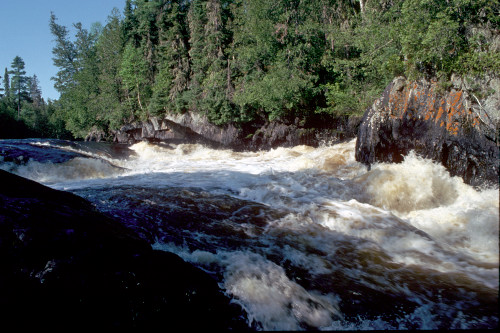
J. Brown
June, 1990
Edits and Summaries:
L. Walter
July, 2006